Comparative Performance Evaluation of Gas Brayton Cycle for Micro–Nuclear Reactors
Abstract
1. Introduction
1.1. Background
1.2. Methods
2. Cycle Design
2.1. S-CO2 Brayton Cycle
2.2. Air Brayton Cycle
3. Design of Turbomachinery
3.1. Polytropic Efficiency for Turbomachinery
| Compressor | Pressure Ratio [-] | Mass Flow Rate [kg/s] | Efficiency [%] | Shaft Speed [RPM] |
|---|---|---|---|---|
| SCIEL | 1.8 | 3.20 | ~65 | 70,000 |
| SNL | 1.82 | 3.53 | 67.53 | 75,000 |
| Japan Institute of Applied Energy | ~1.5 | 1.20 | ~60 | 100,000 |
| IST | 1.80 | 5.46 | 60.78 | 75,000 |
| KIER | 1.75 | 3.70 | ~65 | 70,000 |
| KAIST | 1.30 | 1.50 | 56 | 40,000 |
| Turbine | Pressure Ratio [-] | Rotor Diameter [mm] | Efficiency [%] | Shaft Speed [RPM] |
|---|---|---|---|---|
| SNL | 1.8 | 68.1 | 84.0 | 75,000 |
| SNL | 1.8 | 68.3 | 85.0 | 75,000 |
| IST | 1.686 | 53.0 | 79.8 | 75,000 |
3.2. Conversion from Polytropic Efficiency to Isentropic Efficiency
4. Cycle Optimization
5. Results and Discussion
5.1. Open-Air Brayton Cycle
5.2. Closed S-CO2 Brayton Cycle
5.3. Comparison of Air and S-CO2 Brayton Cycles
6. Conclusions
Author Contributions
Funding
Acknowledgments
Conflicts of Interest
Nomenclature
| Symbol | Description | Unit |
| Efficiency | % | |
| Enthalpy change | ||
| Mass Flow Rate | ||
| Pressure Ratio | - | |
| Rotor shroud Diameter | mm | |
| Specific Speed | - | |
| Specific diameter | - | |
| Temperature | °C | |
| Pressure | MPa | |
| Isentropic Coefficient | - | |
| n | Polytropic Coefficient | - |
| Z | Compressibility Factor | - |
| D | Rotor Diameter | m |
| Rotational Speed | ||
| V | Volumetric Flow Rate | |
| g | Gravitational Acceleration | |
| Adiabatic Head | m | |
| Subscripts | ||
| Poly | Polytropic | - |
| S | Stage | - |
| Isen | Isentropic | - |
| t, turb | Turbine | - |
| c, comp | Compressor | - |
Appendix A
References
- Fleming, D.; Holschuh, T.; Conboy, T.; Rochau, G.; Fuller, R. Scaling Considerations for a Multi-Megawatt Class Supercritical CO2 Brayton Cycle and Path Forward for Commercialization. In Turbo Expo: Power for Land, Sea, and Air; American Society of Mechanical Engineers: New York, NY, USA, 2012; Volume 44717. [Google Scholar] [CrossRef]
- Testoni, R.; Bersano, A.; Segantin, S. Review of nuclear microreactors: Status, potentialities and challenges. Prog. Nucl. Energy 2021, 138, 103822. [Google Scholar] [CrossRef]
- Swartz, M.M.; Byers, W.A.; Lojek, J.; Blunt, R. Westinghouse eVinci™ Heat Pipe Micro Reactor Technology Development. In International Conference on Nuclear Engineering; American Society of Mechanical Engineers: New York, NY, USA, 2021; Volume 85246. [Google Scholar] [CrossRef]
- Xu, J.; Liu, C.; Sun, E.; Xie, J.; Li, M.; Yang, Y.; Liu, J. Perspective of S−CO2 power cycles. Energy 2019, 186, 115831. [Google Scholar] [CrossRef]
- Rogalev, N.; Rogalev, A.; Kindra, V.; Zlyvko, O.; Bryzgunov, P. Review of Closed SCO2 and Semi-Closed Oxy–Fuel Combustion Power Cycles for Multi-Scale Power Generation in Terms of Energy, Ecology and Economic Efficiency. Energies 2022, 15, 9226. [Google Scholar] [CrossRef]
- Rogalev, N.; Rogalev, A.; Kindra, V.; Komarov, I.; Zlyvko, O. Structural and Parametric Optimization of S–CO2 Nuclear Power Plants. Entropy 2021, 23, 1079. [Google Scholar] [CrossRef] [PubMed]
- Persichilli, M.; Kacludis, A.; Zdankiewicz, E.; Held, T. Supercritical CO2 Power Cycle Developments and Commercialization: Why sCO2 can Displace Steam Ste; Power-Gen India & Central Asia: New Delhi, India, 2012; pp. 19–21. [Google Scholar]
- Dostal, V.; Driscoll, M.; Hejzlar, P. A Supercritical Carbon Dioxide Cycle for Next Generation Nuclear Reactor; Massachusetts Institute of Technology: Cambridge, MA, USA, 2004; Volume MIT-ANP-TR-100. [Google Scholar]
- Buongiorno, J.; Carmichael, B.; Dunkin, B.; Parsons, J.; Smit, D. Can Nuclear Batteries Be Economically Competitive in Large Markets? Energies 2021, 14, 4385. [Google Scholar] [CrossRef]
- Dimitrakopoulos, P. A Generalized Method for the Comparable and Rigorous Calculation of the Polytropic Efficiencies of Turbocompressors. Int. J. Turbo Jet-Engines 2018, 35, 35–47. [Google Scholar] [CrossRef]
- Atkins, A.G.; Atkins, T.; Escudier, M. A Dictionary of Mechanical Engineering; Oxford University Press: Oxford, UK, 2013. [Google Scholar]
- Pandey, V.; Kumar, P.; Dutta, P. Thermo-hydraulic analysis of compact heat exchanger for a simple recuperated sCO2 Brayton cycle. Renew. Sustain. Energy Rev. 2020, 134, 110091. [Google Scholar] [CrossRef]
- Marion, J.; Lariviere, B.; McClung, A.; Mortzheim, J. The STEP 10 MWe CO2 Pilot Demonstration Status Update. In Turbo Expo: Power for Land, Sea, and Air; American Society of Mechanical Engineers: New York, NY, USA, 2021; Volume 85048. [Google Scholar]
- Cha, J.E.; Bae, S.W.; Lee, J.; Cho, S.K.; Lee, J.I.; Park, J.H. Operation results of a closed supercritical CO2 simple Brayton cycle. In Proceedings of the 5th International Symposium-Supercritical CO2 Power Cycles, San Antonio, TX, USA, 28–31 March 2016. [Google Scholar]
- Wright, S.A.; Radel, R.F.; Vernon, M.E.; Pickard, P.S.; Rochau, G.E. Operation and Analysis of a Supercritical CO2 Brayton Cycle; No. SAND2010-0171; Sandia National Laboratories (SNL): Albuquerque, NM, USA; Livermore, CA, USA, 2010. [CrossRef]
- Ahn, Y.; Bae, S.J.; Kim, M.; Cho, S.K.; Baik, S.; Lee, J.I.; Cha, J.E. Review of supercritical CO2 power cycle technology and current status of research and development. Nucl. Eng. Technol. 2015, 47, 647–661. [Google Scholar] [CrossRef]
- Guillen, D.; McDaniel, P. An evaluation of power conversion systems for land-based nuclear microreactors: Can aeroderivative engines facilitate near-term deployment? Nucl. Eng. Technol. 2022, 54, 1482–1494. [Google Scholar] [CrossRef]
- Litrel, J.; Guillen, D.; McKellar, M. Evaluation of Organic Rankine Cycles in an Air-Brayton Combined Cycle for Microreactor Applications; No. INL/CON-18-45753-Rev000; Idaho National Lab. (INL): Idaho Falls, ID, USA, 2018.
- Lee, G.T.; Sudhoff, F.A. Fuel Cell/Gas Turbine System Performance Studies; No. DOE/METC/C-97/7278; CONF-9608152-3; USDOE Morgantown Energy Technology Center (METC): Morgantown, WV, USA, 1996.
- Sterbentz, J.W.; Werner, J.E.; McKellar, M.G.; Hummel, A.J.; Kennedy, J.C.; Wright, R.N.; Biersdorf, J.M. Special Purpose Nuclear Reactor (5 MW) for Reliable Power at Remote Sites Assessment Report; No. INL/EXT-16-40741; Idaho National Lab. (INL): Idaho Falls, ID, USA, 2017. [CrossRef]
- Wilson, D.G.; Korakianitis, T. The Design of High-Efficiency Turbomachinery and Gas Turbines; MIT Press: Cambridge, MA, USA, 2014. [Google Scholar] [CrossRef]
- Lee, J.; Kim, S.G.; Cha, J.E.; Lee, J.I. Uncertainty on performance measurement of S-CO2 compressor operating near the critical point. In Proceedings of the 4th International Supercritical CO2 Power Cycles, Pittsburgh, PA, USA, 9–10 September 2014. [Google Scholar]
- Clementoni, E.M.; Cox, T.L.; Sprague, C.P. Startup and Operation of a Supercritical Carbon Dioxide Brayton Cycle. J. Eng. Gas Turbines Power 2014, 136, 071701. [Google Scholar] [CrossRef]
- Kimball, K.J.; Clementoni, E.M. Supercritical Carbon Dioxide Brayton Power Cycle Development Overview. In Turbo Expo: Power for Land, Sea, and Air; American Society of Mechanical Engineers: New York, NY, USA, 2012; Volume 44717. [Google Scholar] [CrossRef]
- Cho, S.K.; Son, S.; Lee, J.; Lee, S.-W.; Jeong, Y.; Oh, B.S.; Lee, J.I. Optimum loss models for performance prediction of supercritical CO2 centrifugal compressor. Appl. Therm. Eng. 2021, 184, 116255. [Google Scholar] [CrossRef]
- White, M.T.; Bianchi, G.; Chai, L.; Tassou, S.A.; Sayma, A.I. Review of supercritical CO2 technologies and systems for power generation. Appl. Therm. Eng. 2021, 185, 116447. [Google Scholar] [CrossRef]
- Cameron, A.C.; Windmeijer, F.A.G. An R-squared measure of goodness of fit for some common nonlinear regression models. J. Econ. 1997, 77, 329–342. [Google Scholar] [CrossRef]
- Son, I.W.; Jeong, Y.H.; Choi, Y.J.; Lee, J.I. Feasibility study of solar-nuclear hybrid system for distributed power source. Energy Convers. Manag. 2021, 230, 113808. [Google Scholar] [CrossRef]
- Son, I.W.; Choi, S.; Kimb, S.J.; Leea, J.I. Thermal-Sizing of the Molten Salt Reactor System with Gas Brayton Cycle. System 2021, 12, 14. [Google Scholar]
- Lemmon, E.; Huber, M.L.; Mclinden, M.O. NIST Standard Reference Database 23: Reference Fluid Thermodynamic and Transport Properties-REFPROP, Version 8.0; National Institute of Standards and Technology: Gaithersburg, MD, USA, 2007.
- Son, S.; Heo, J.Y.; Lee, J.I. Prediction of inner pinch for supercritical CO2 heat exchanger using Artificial Neural Network and evaluation of its impact on cycle design. Energy Convers. Manag. 2018, 163, 66–73. [Google Scholar] [CrossRef]
- Baljé, O.E. A Study on Design Criteria and Matching of Turbomachines: Part A—Similarity Relations and Design Criteria of Turbines. J. Eng. Power 1962, 84, 83–102. [Google Scholar] [CrossRef]
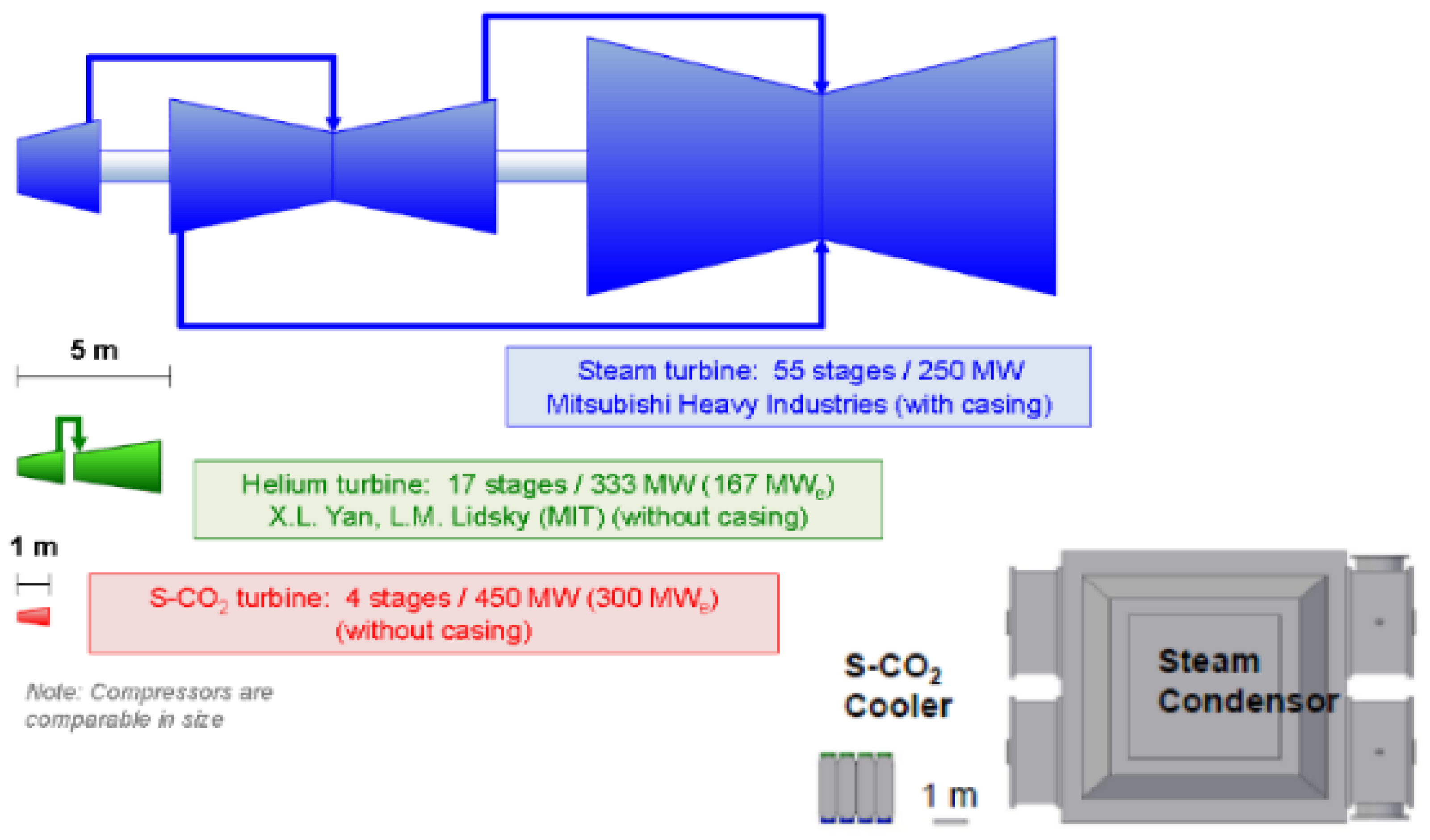
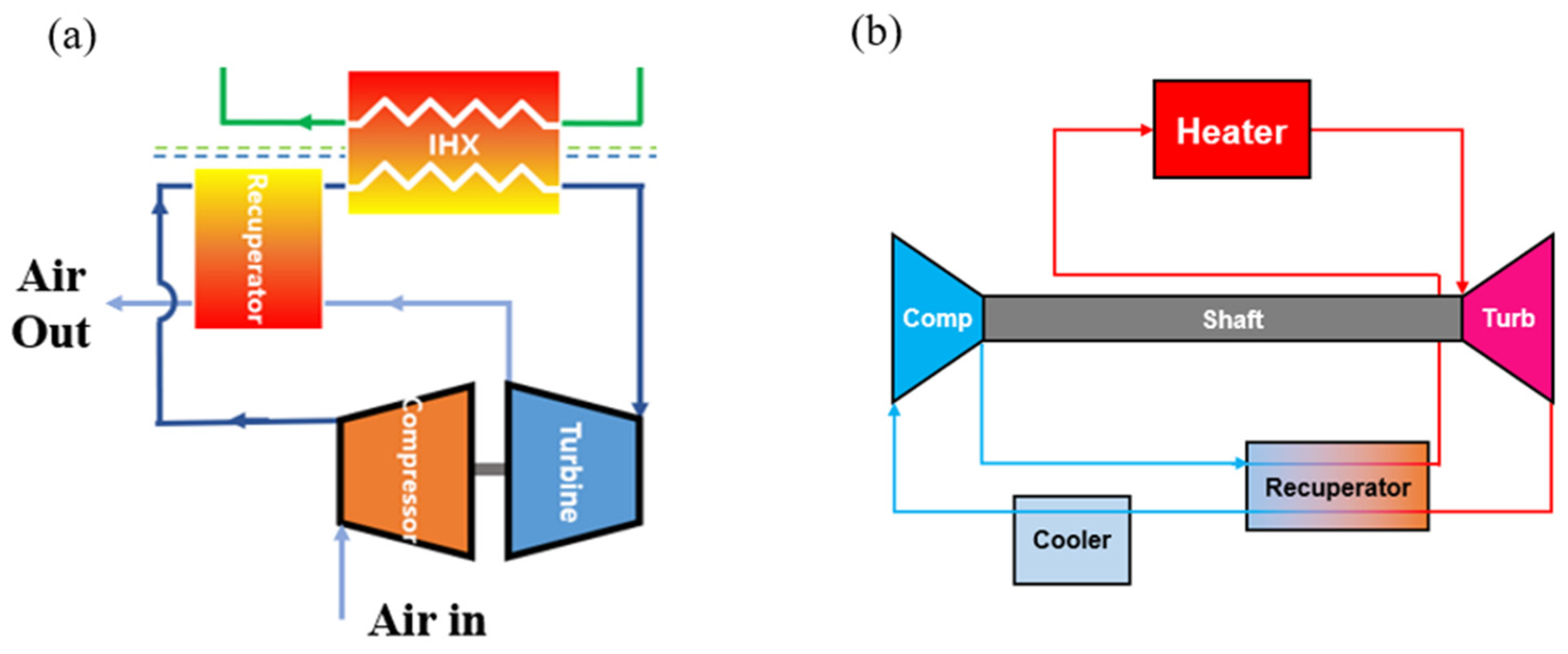
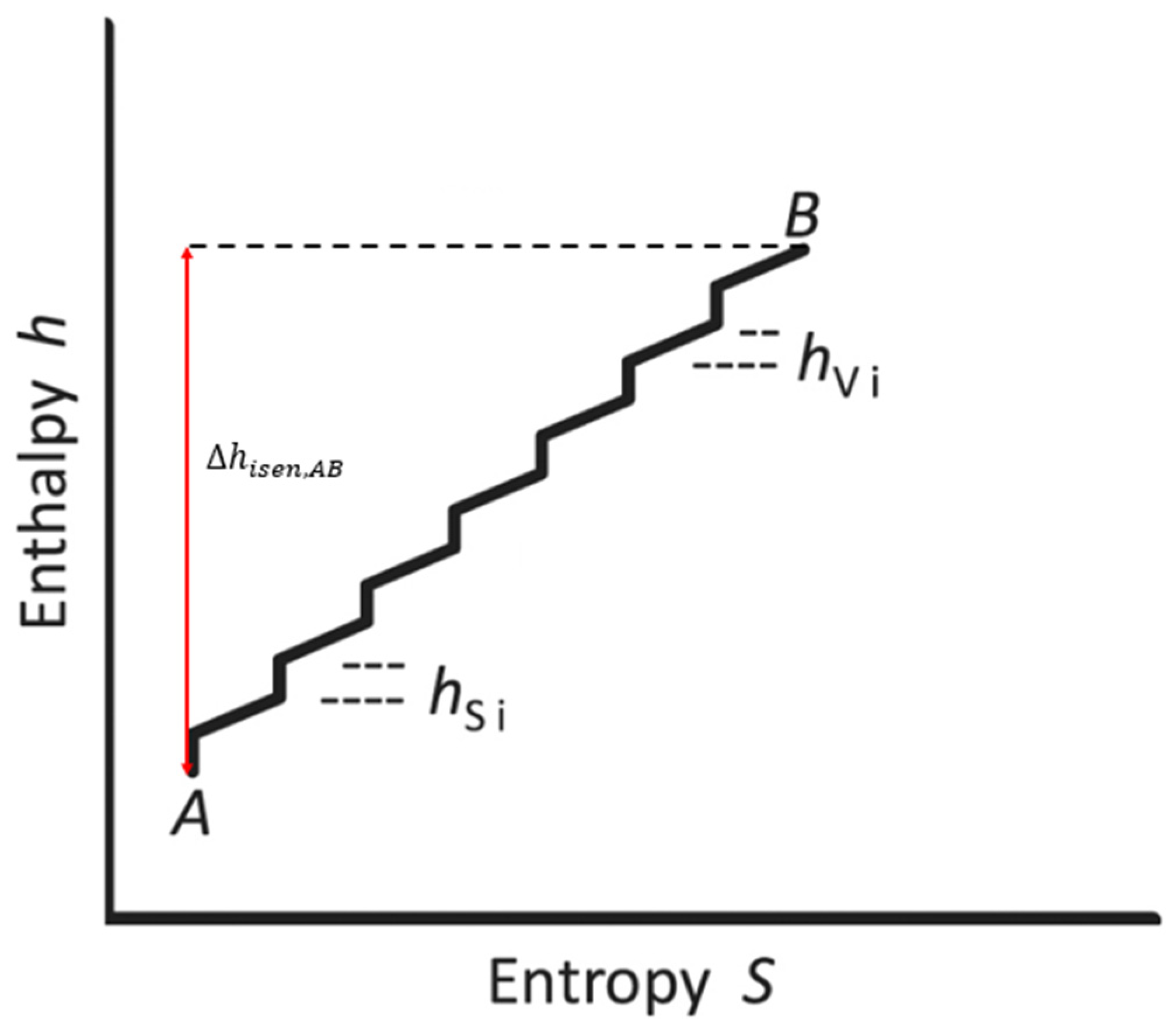



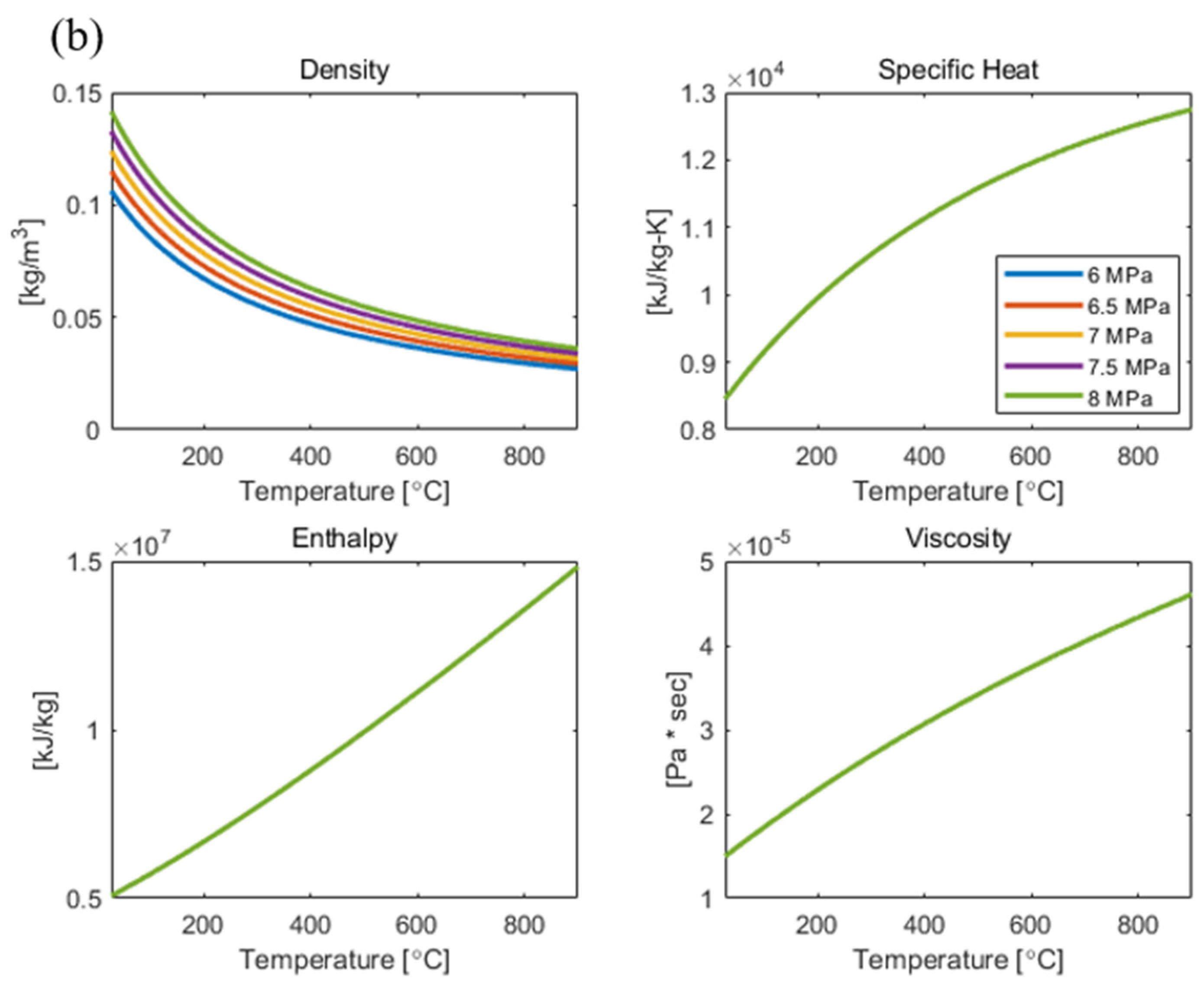
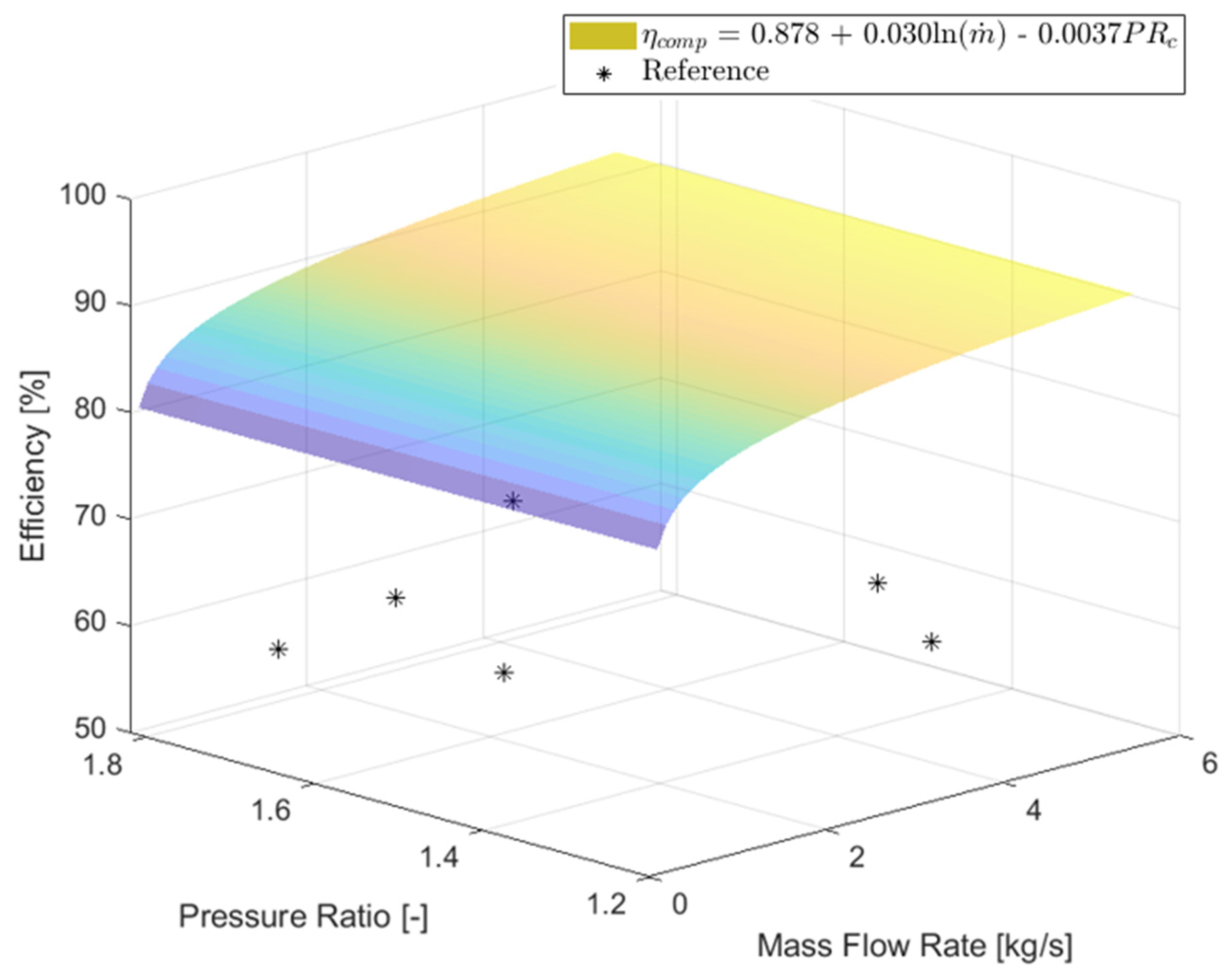
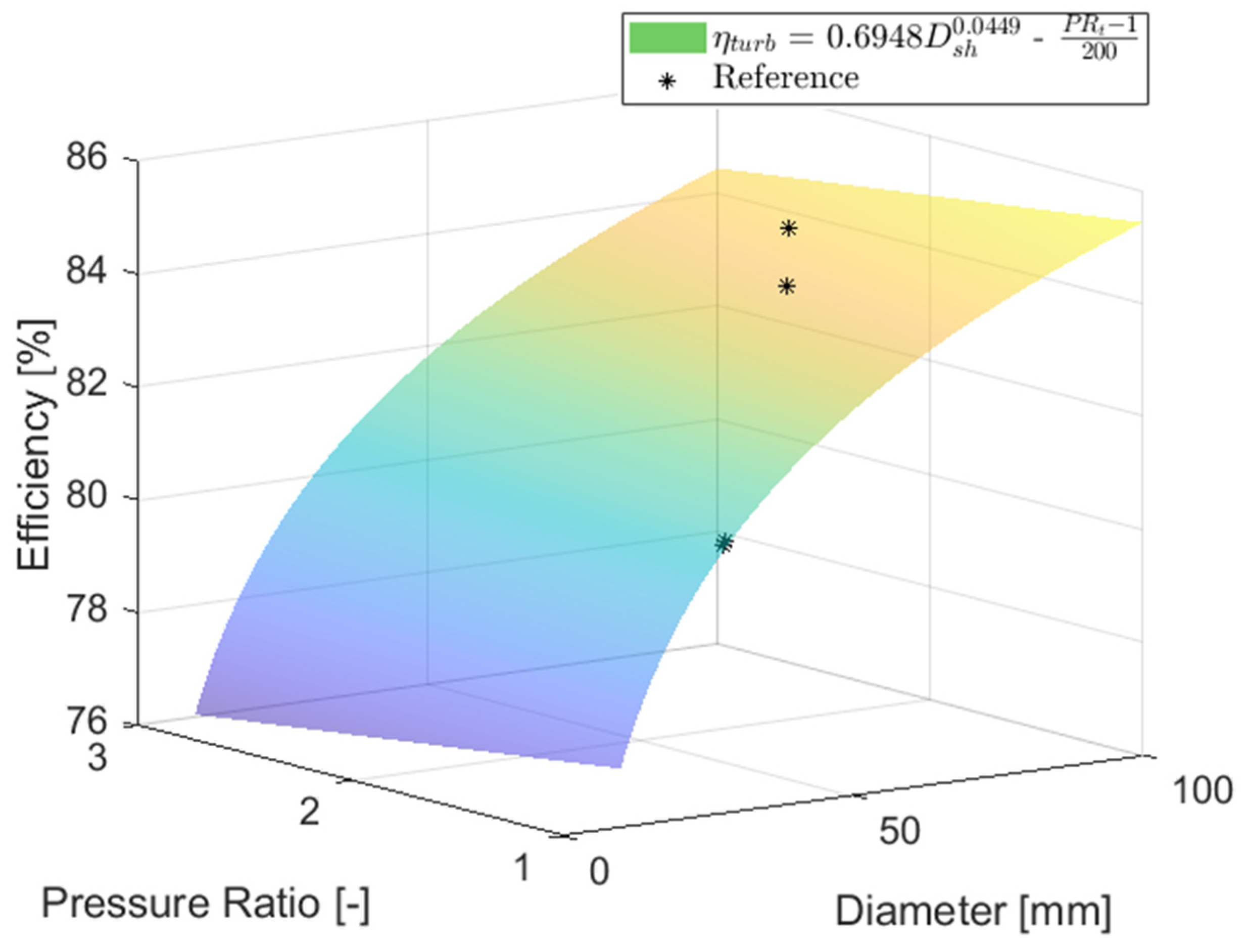
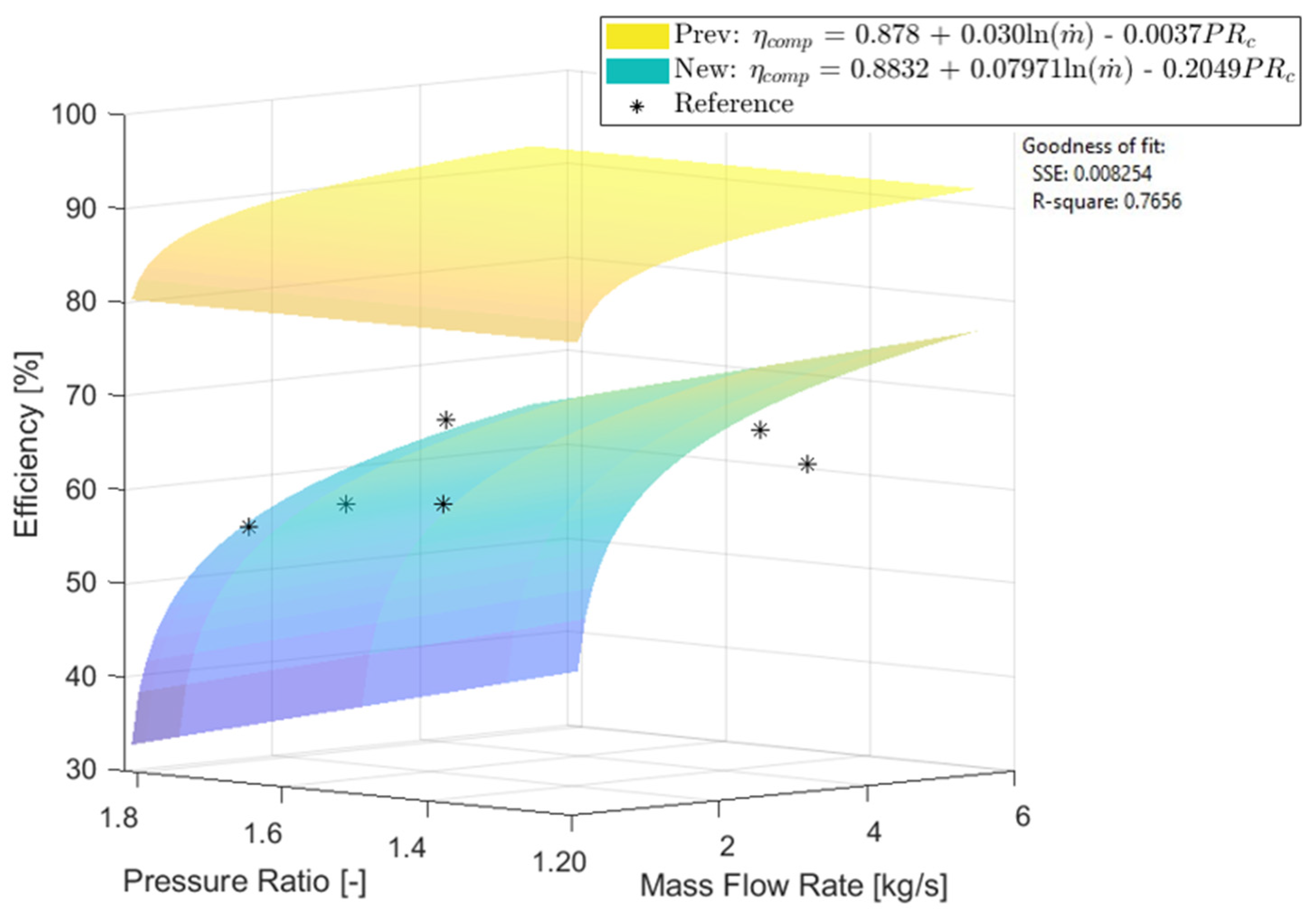
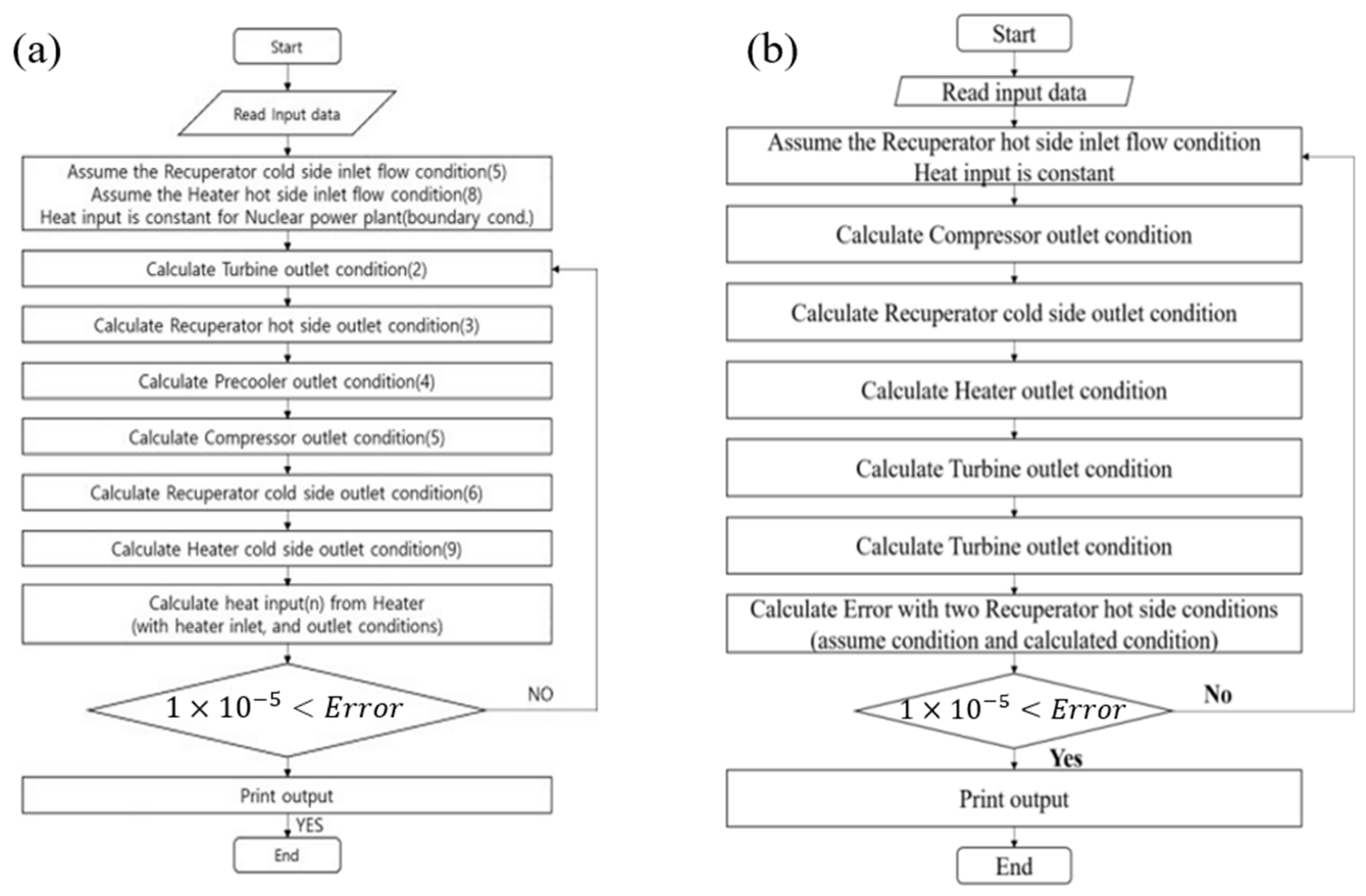
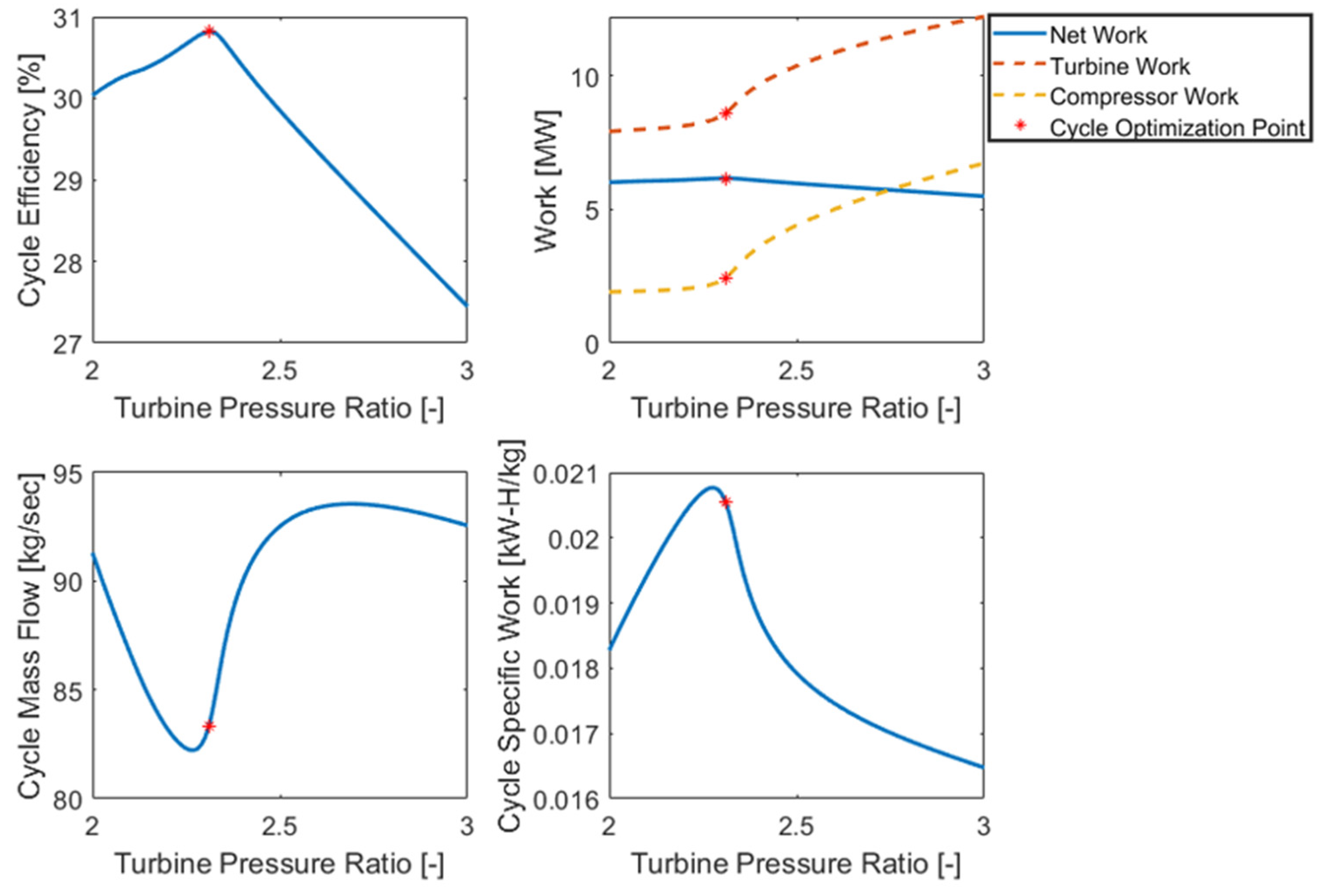
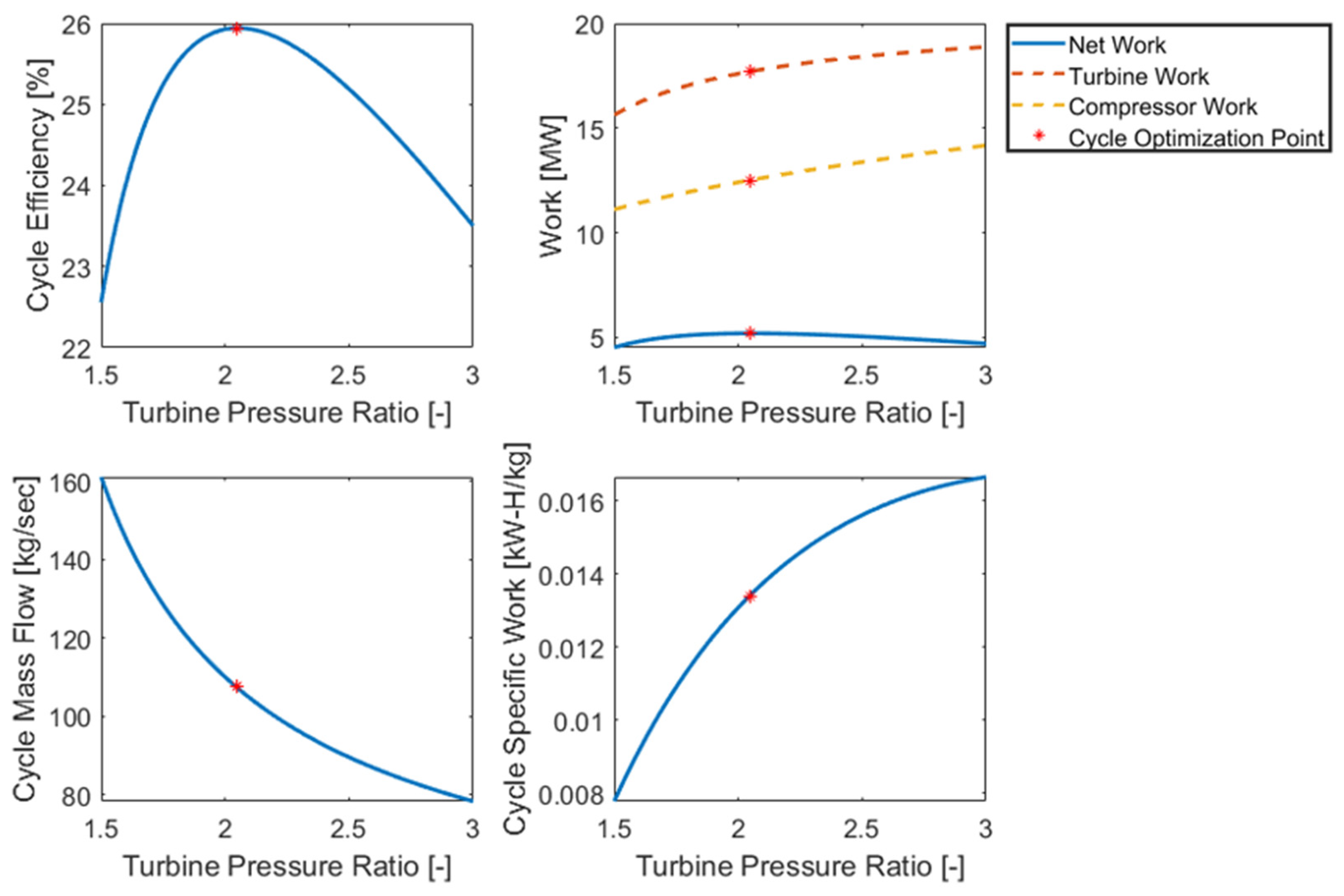
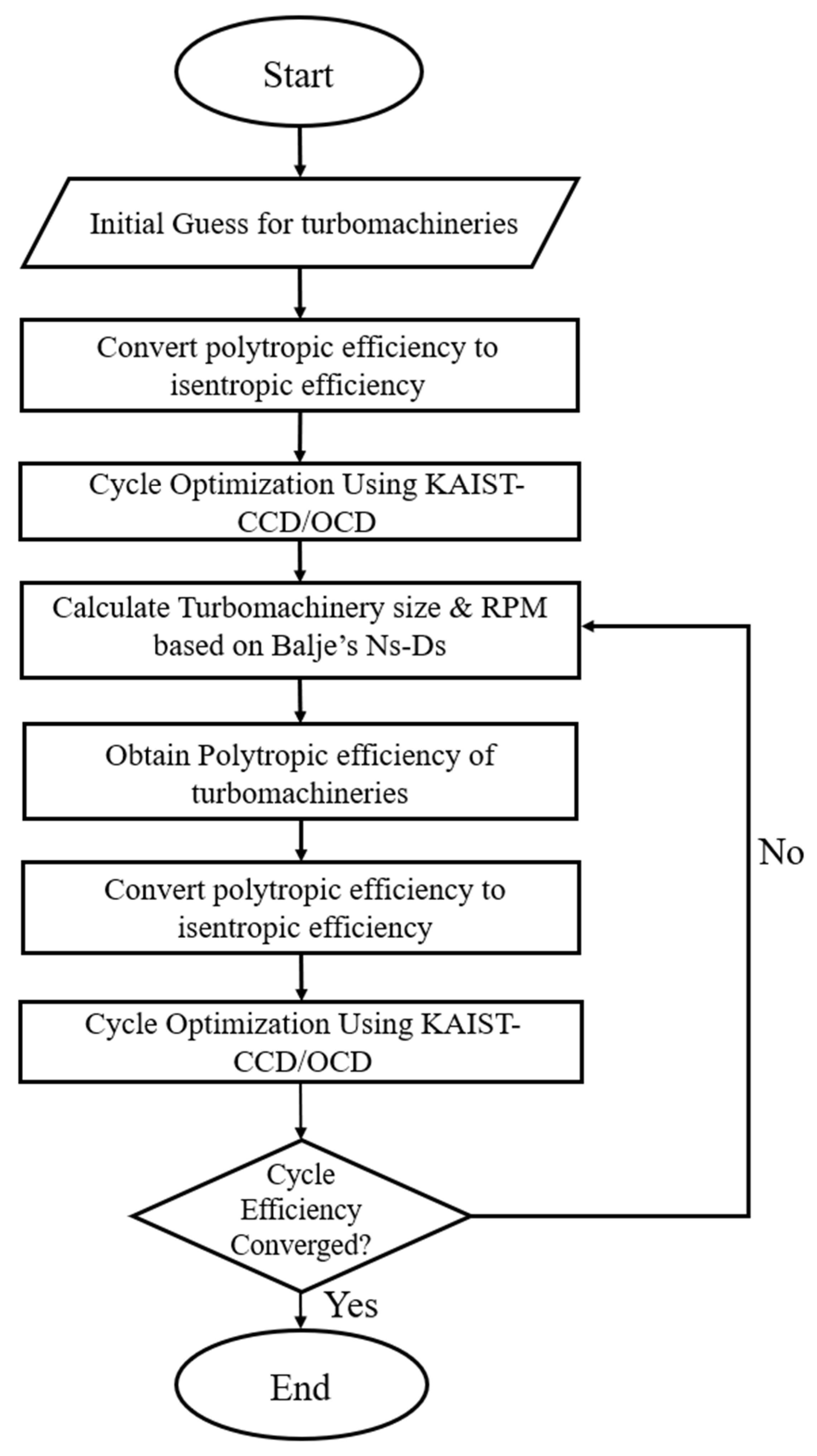
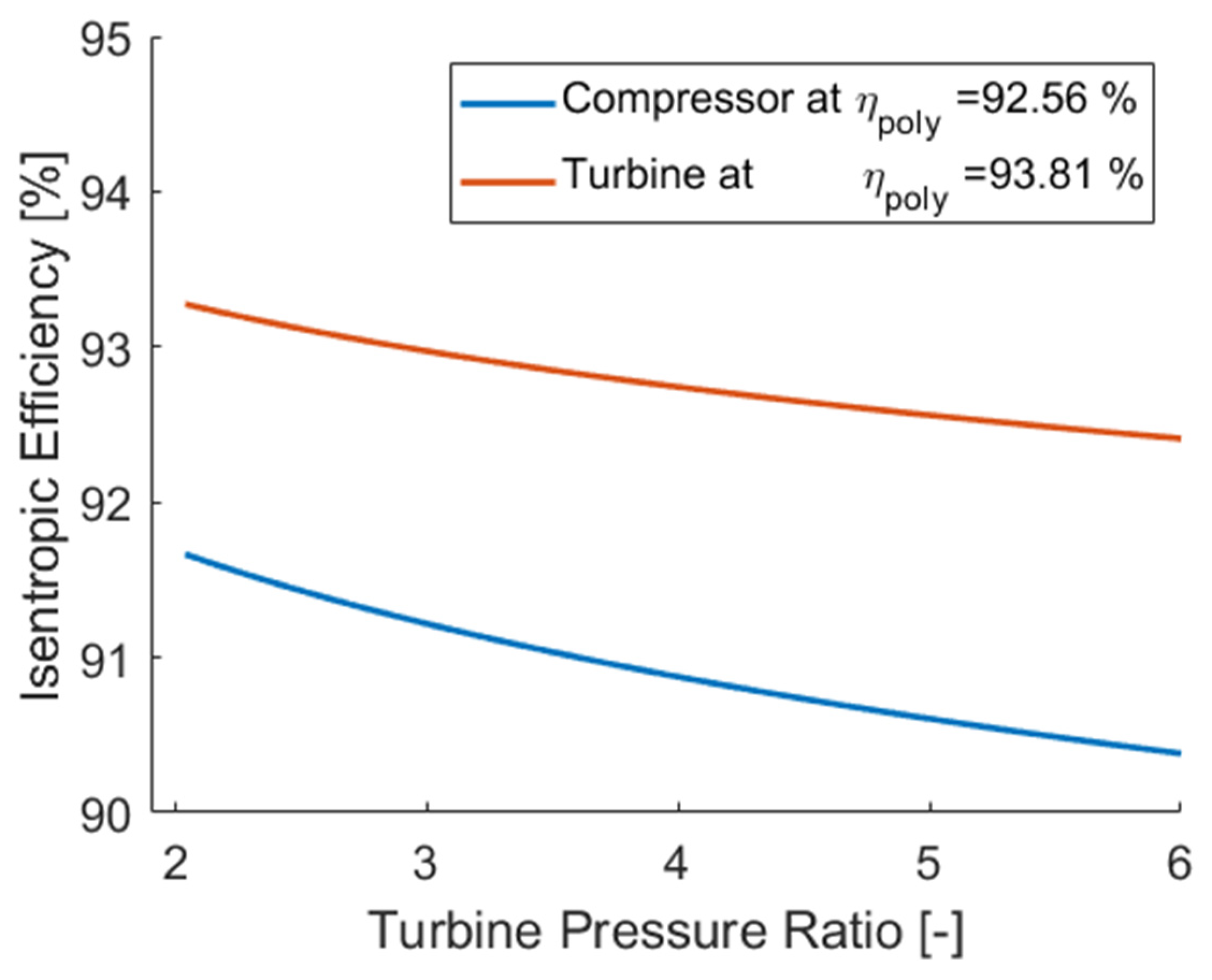
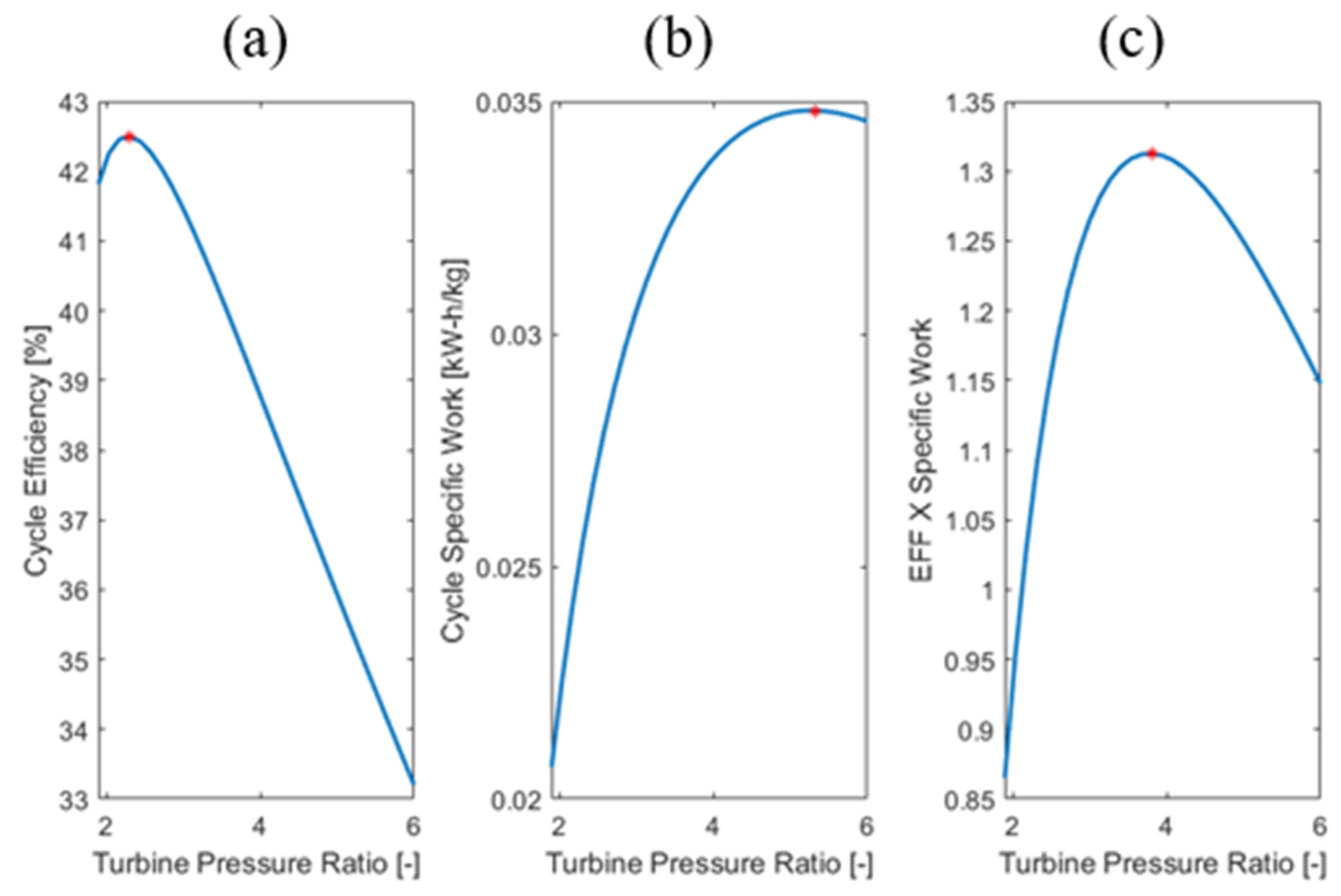
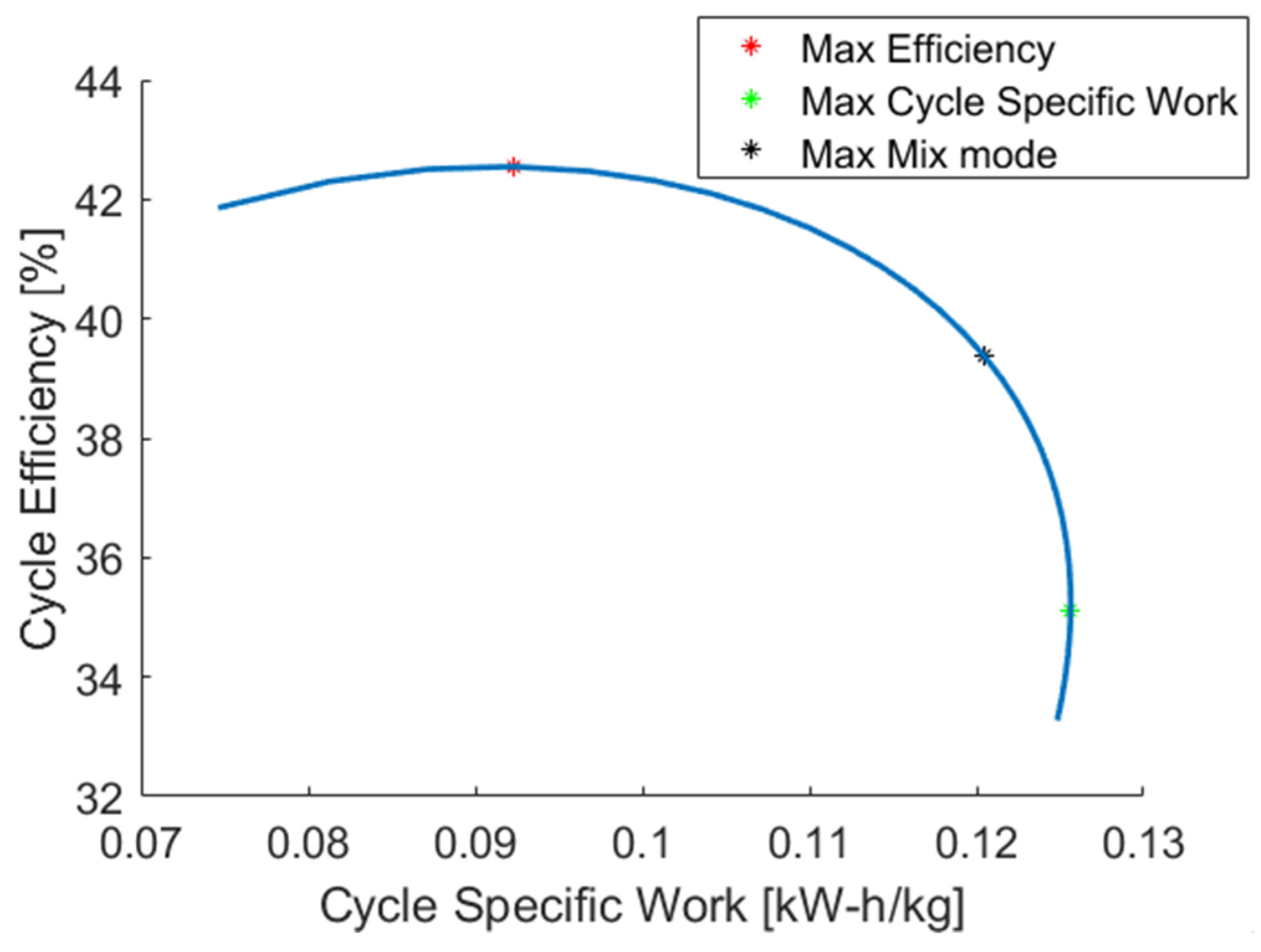
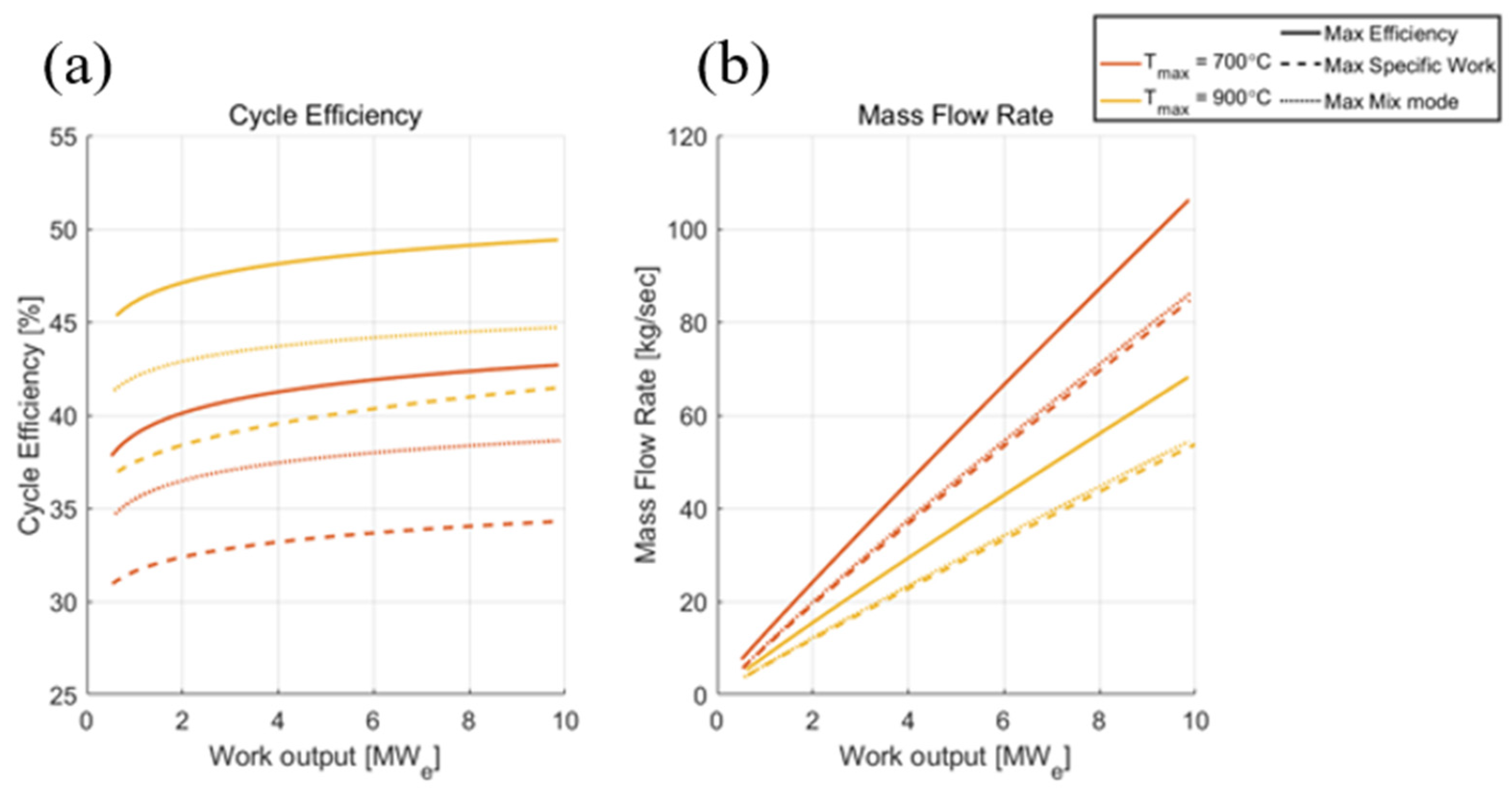
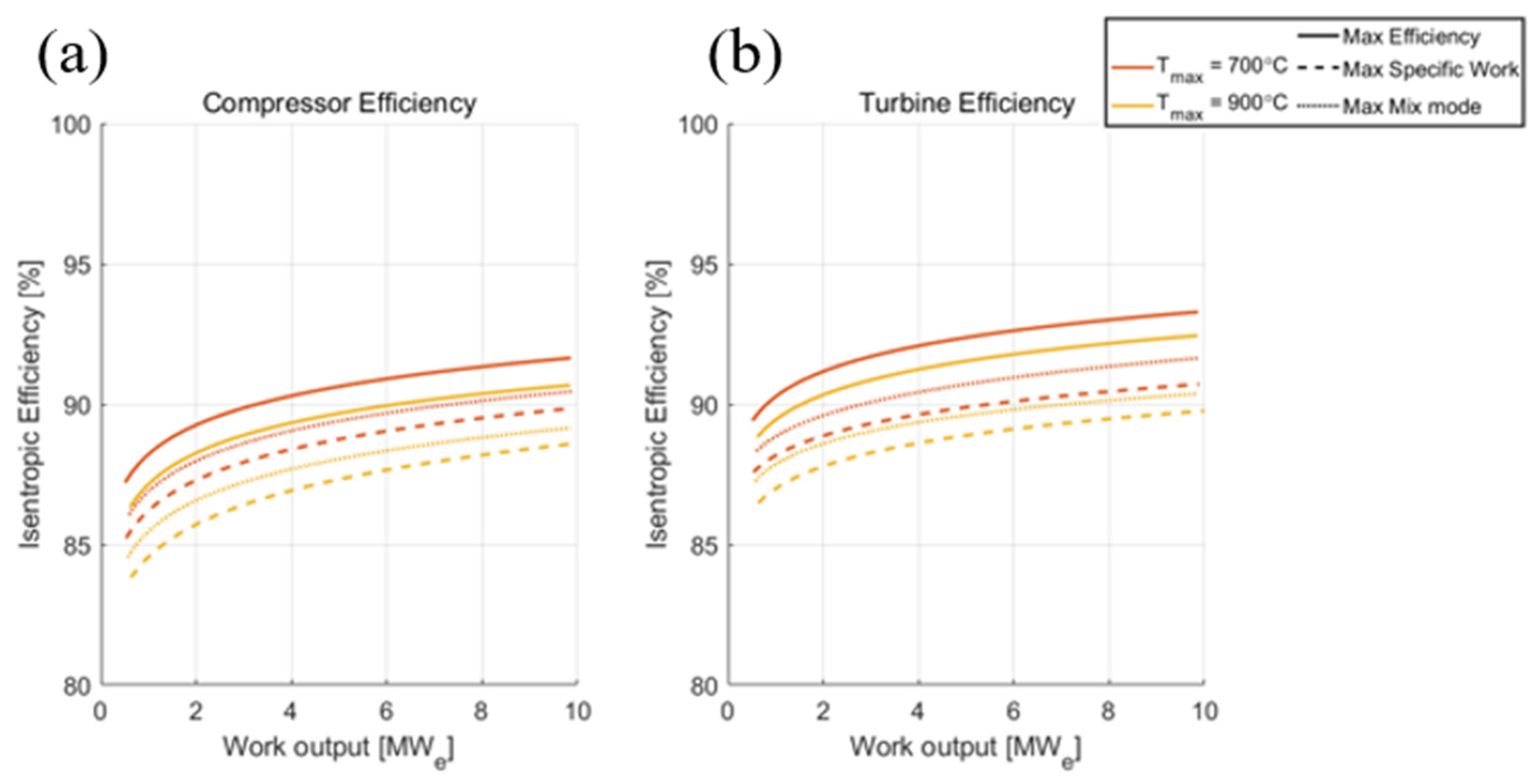
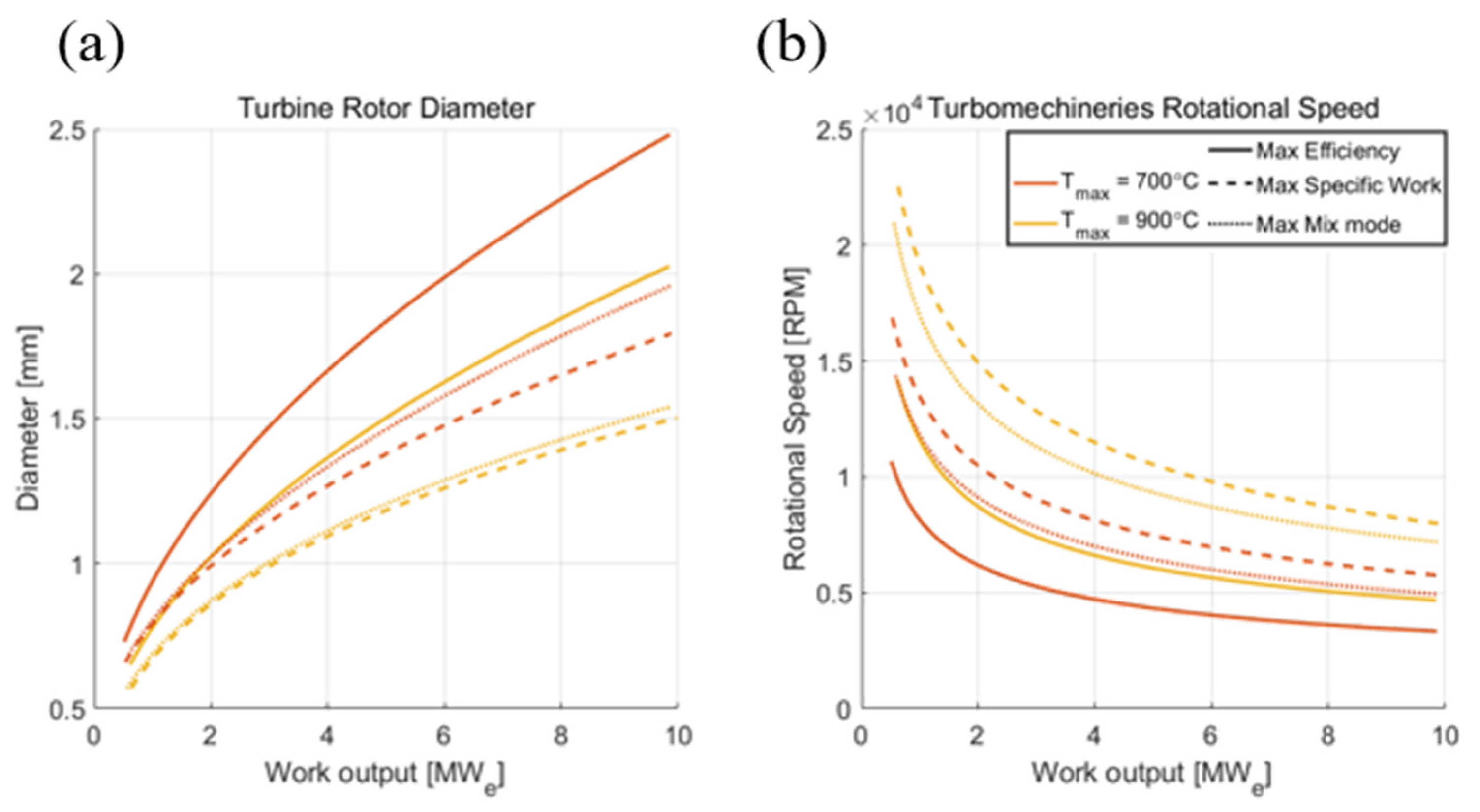
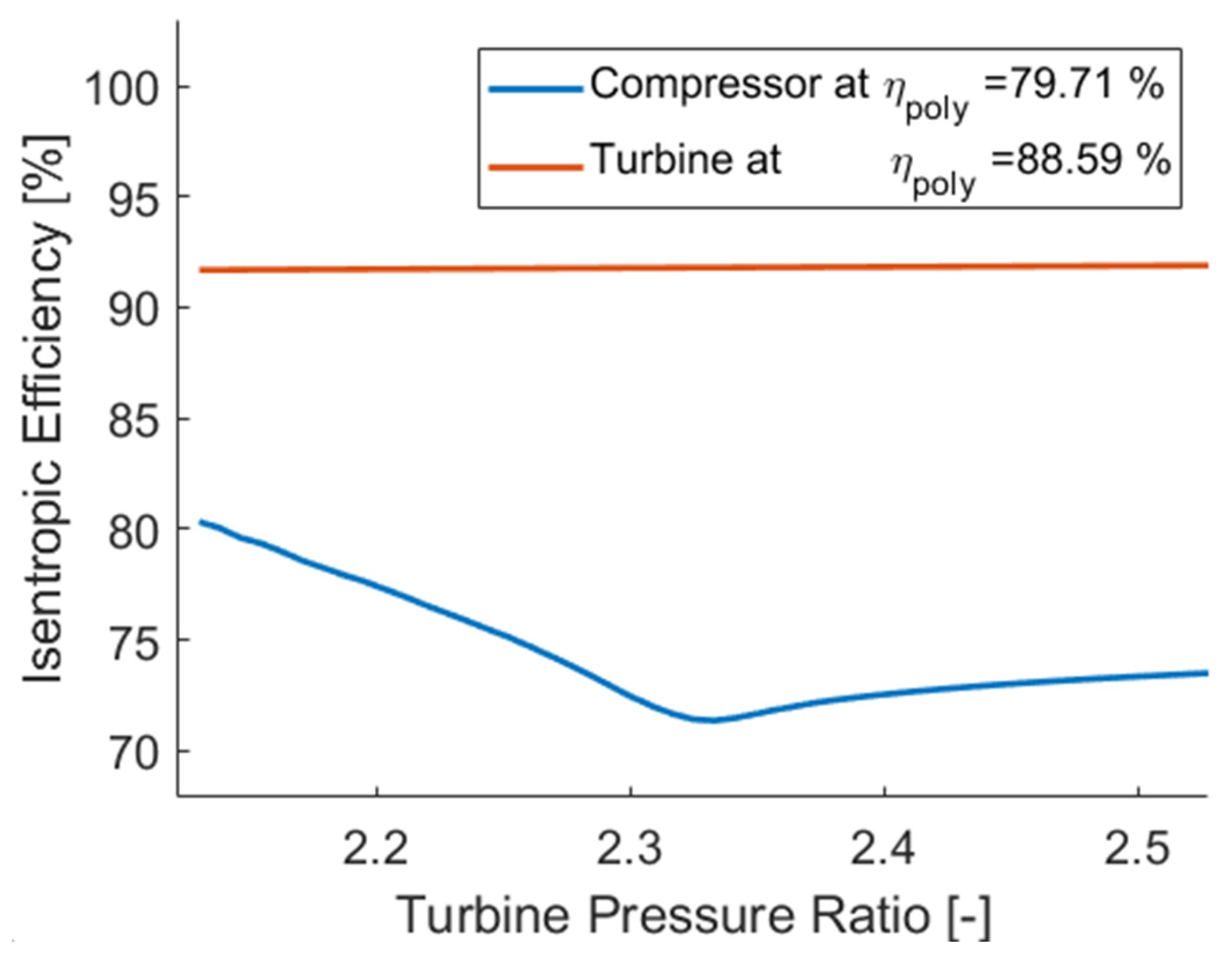
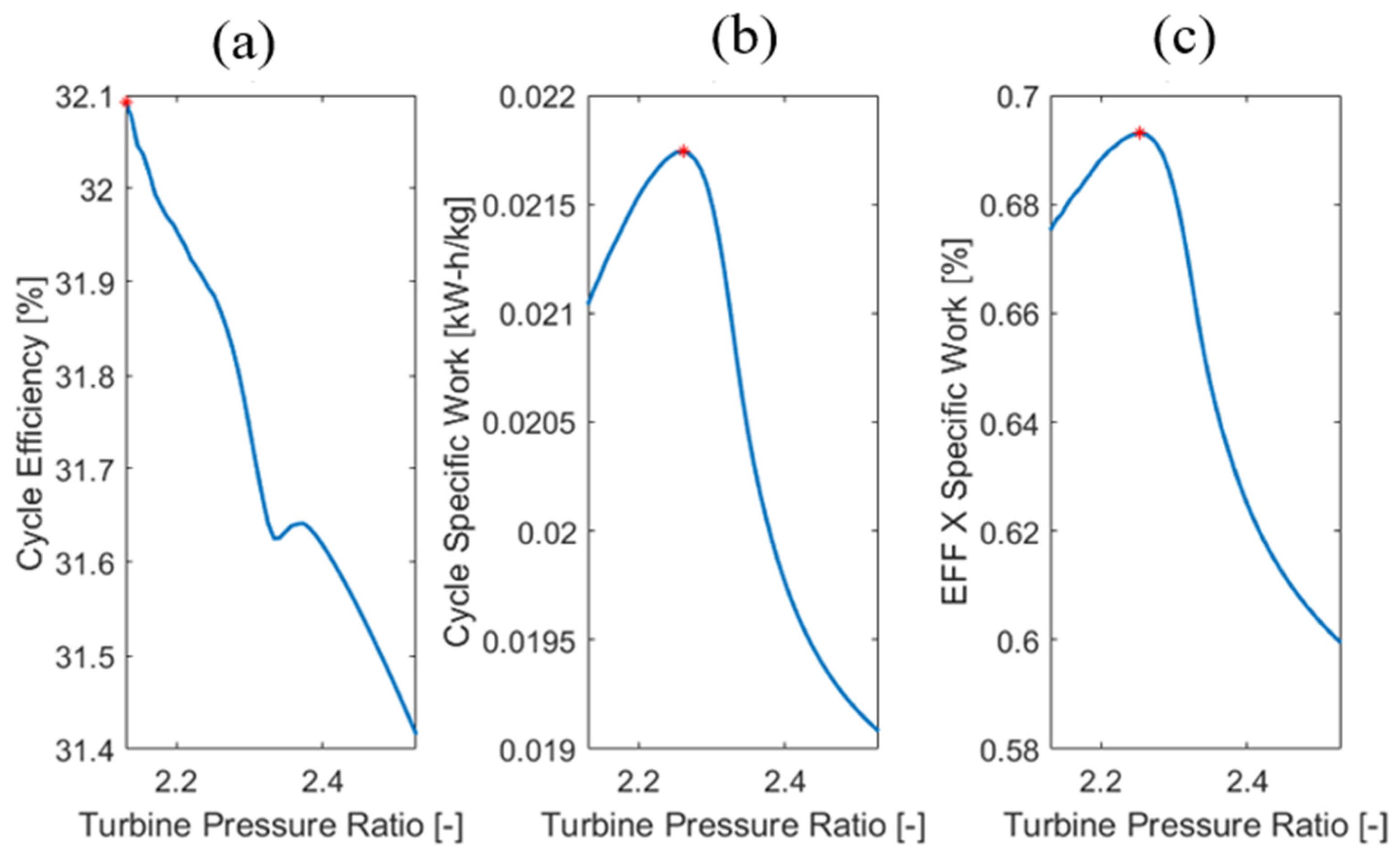
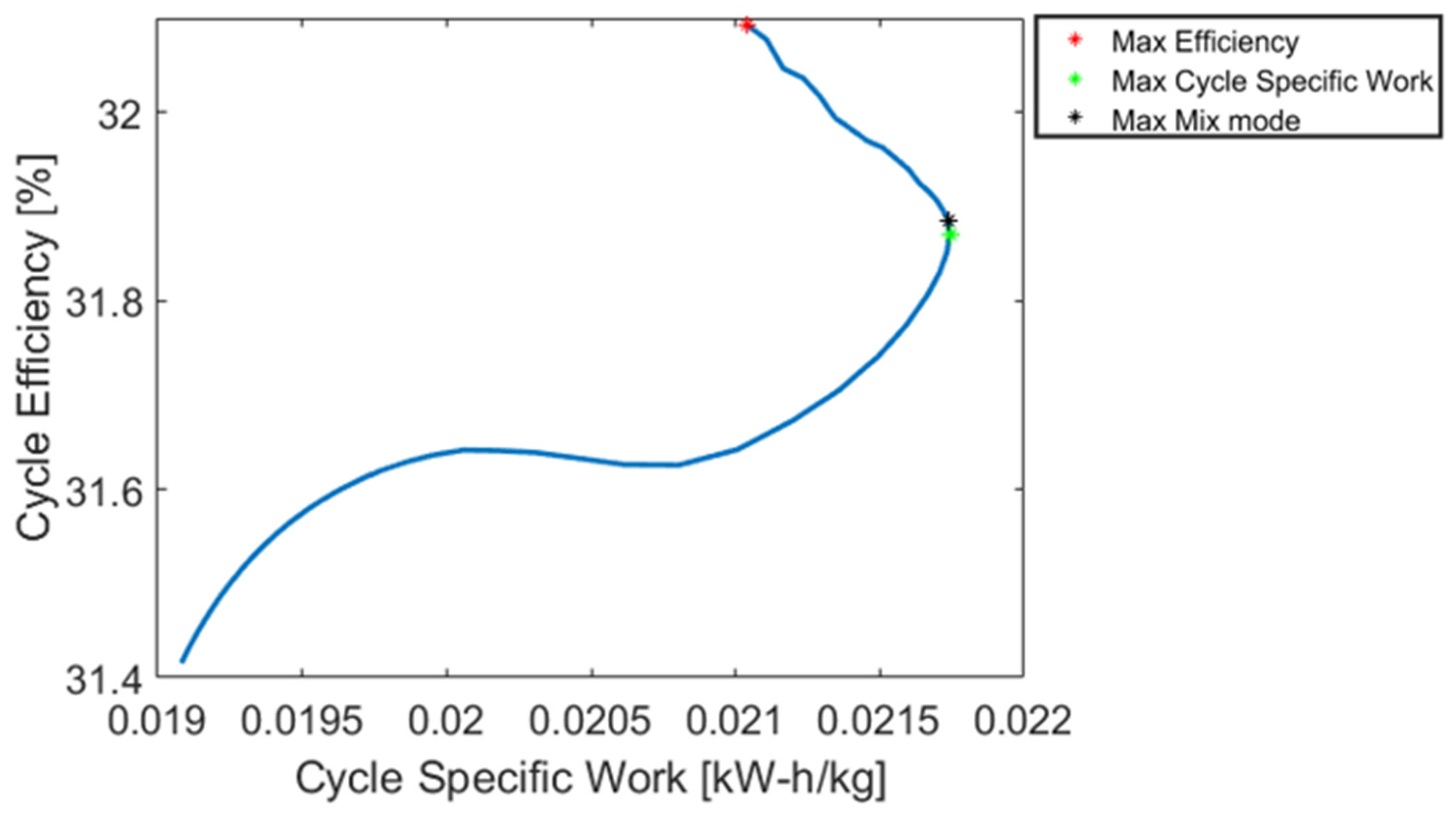
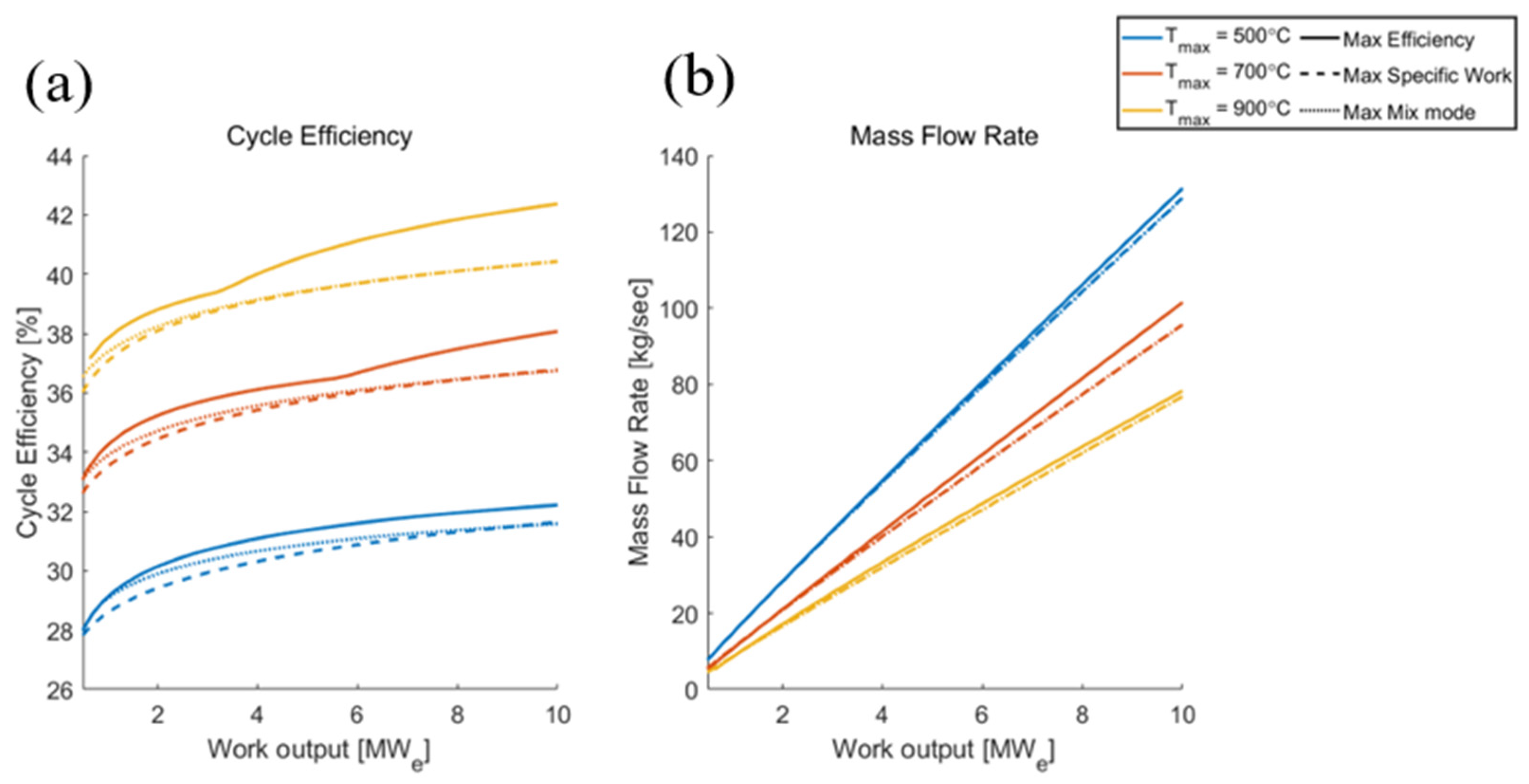
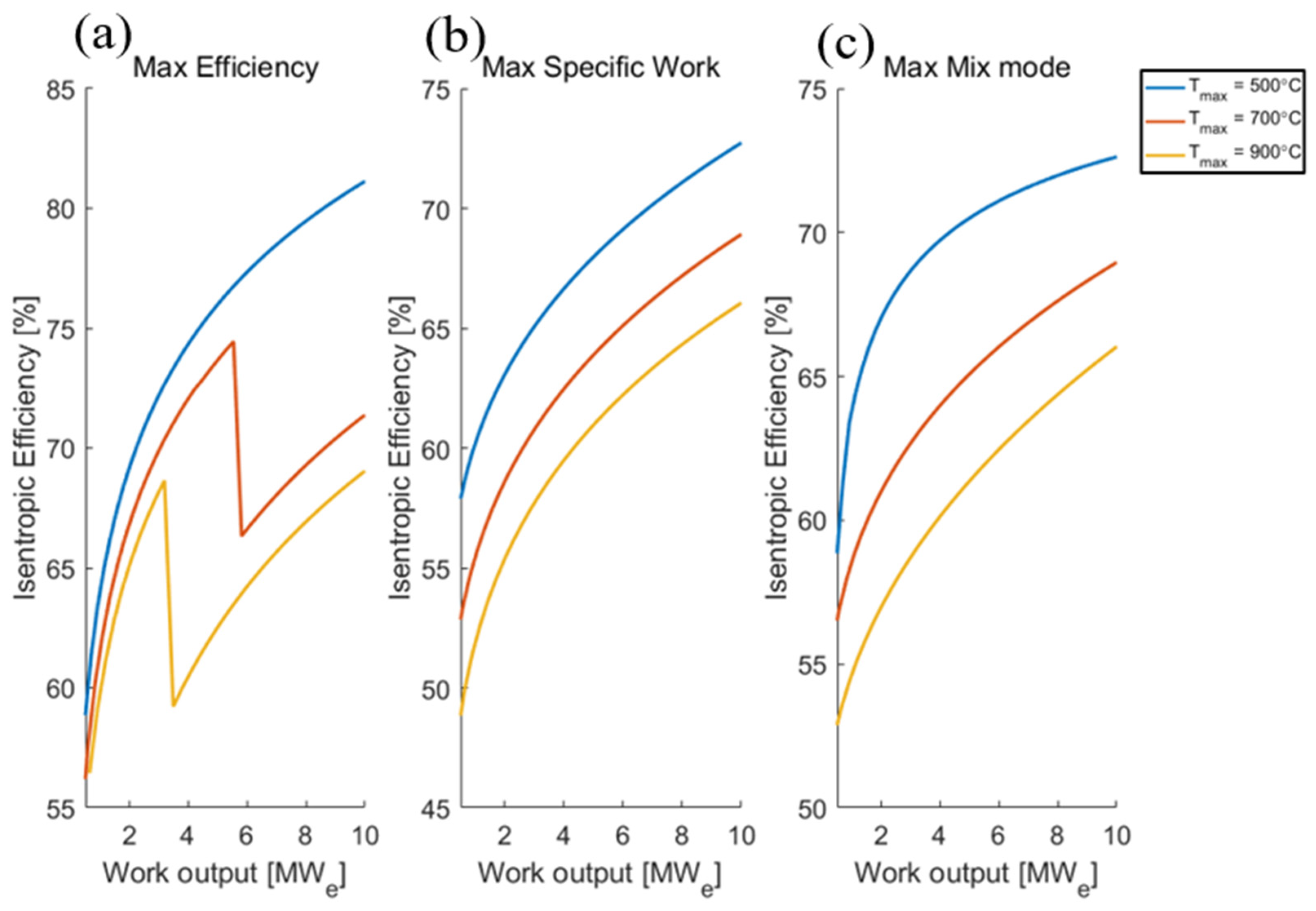
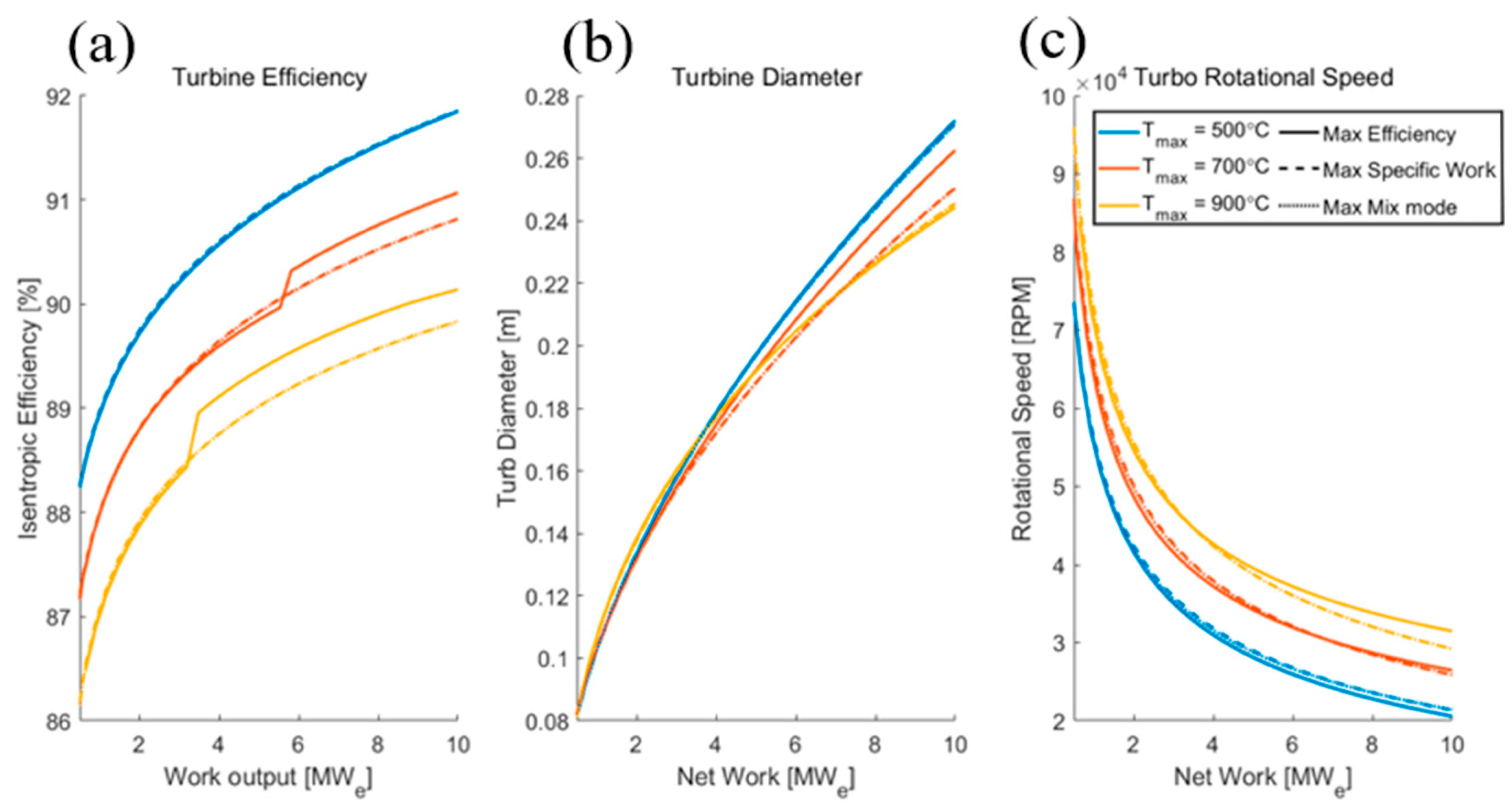

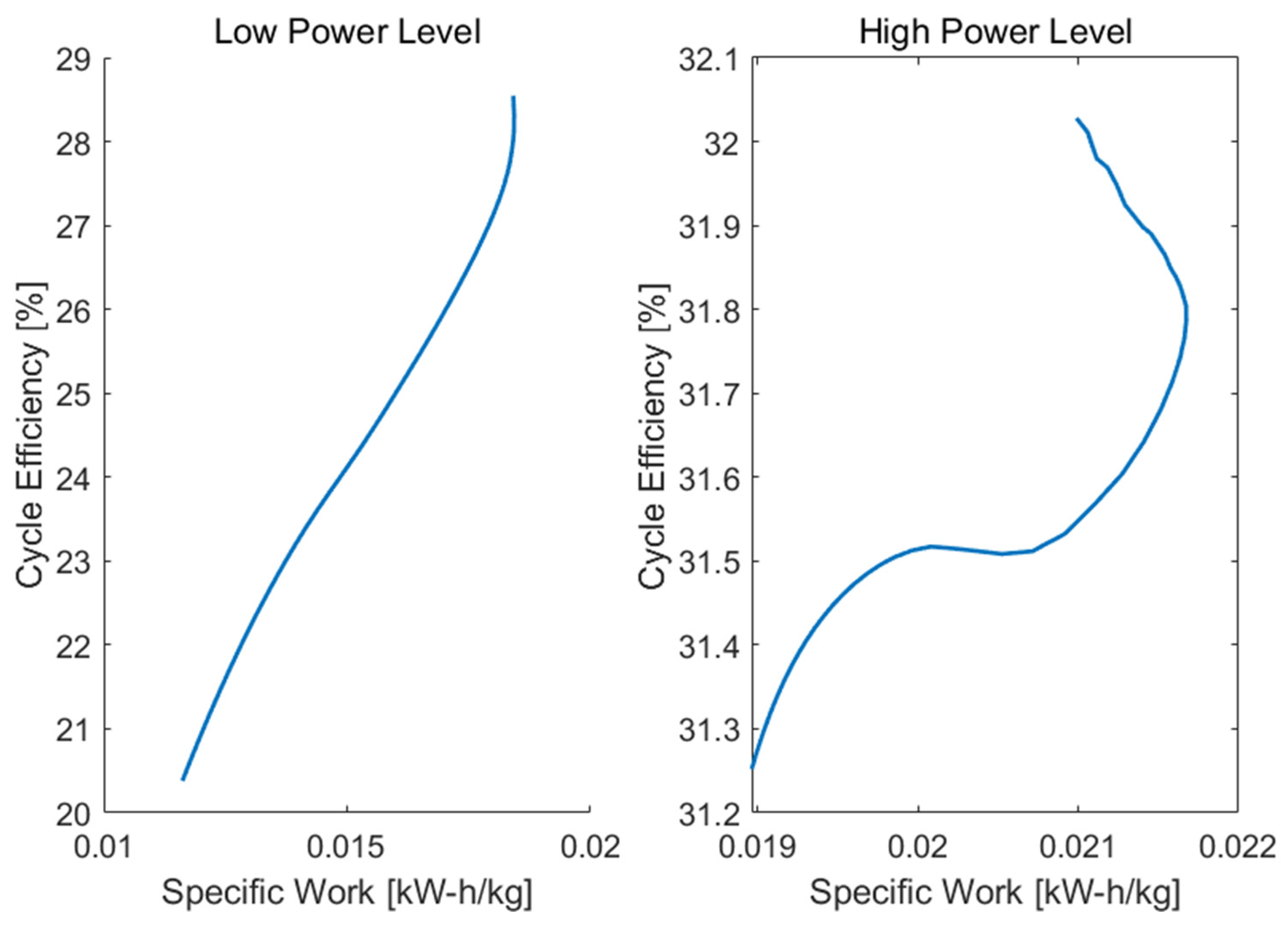
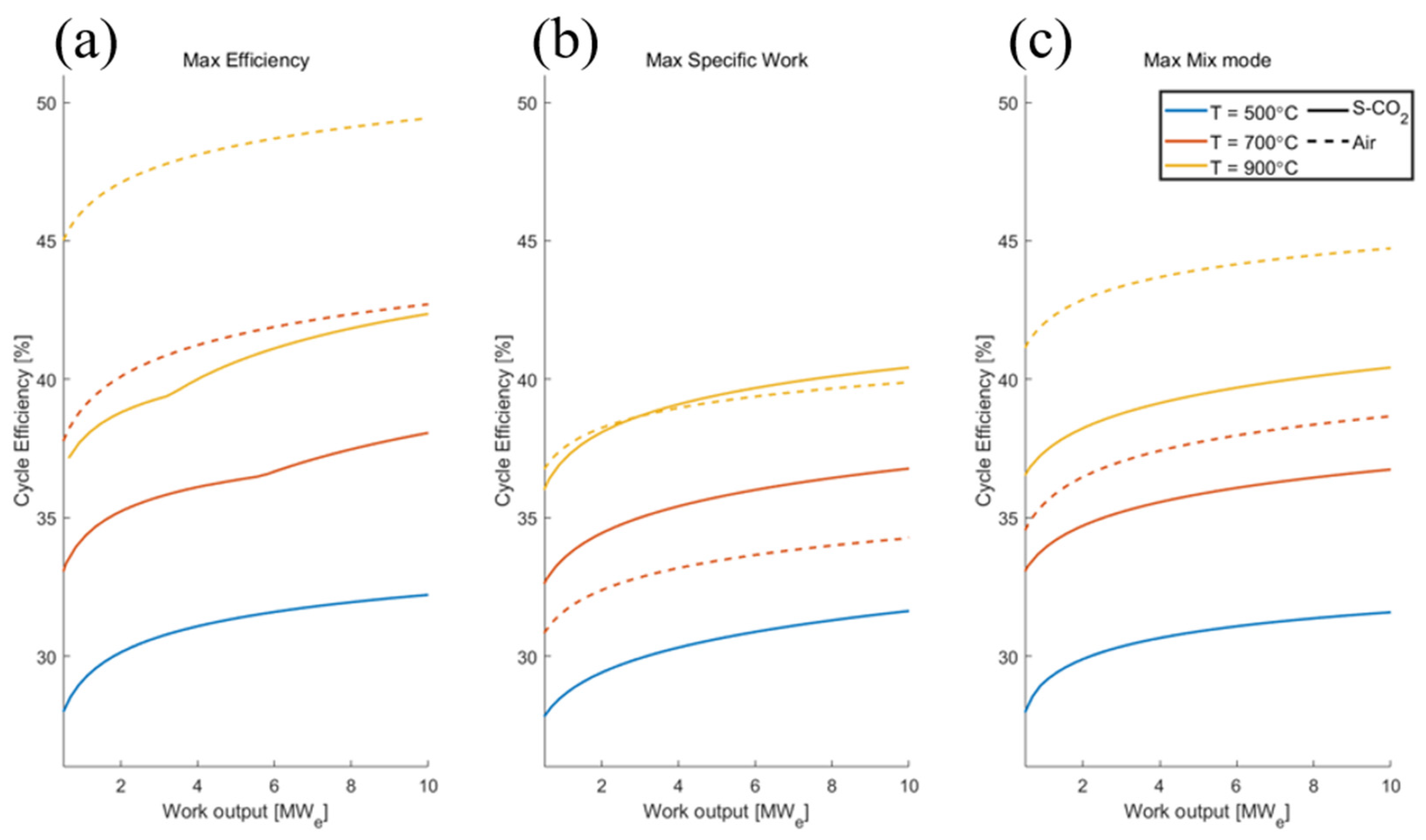
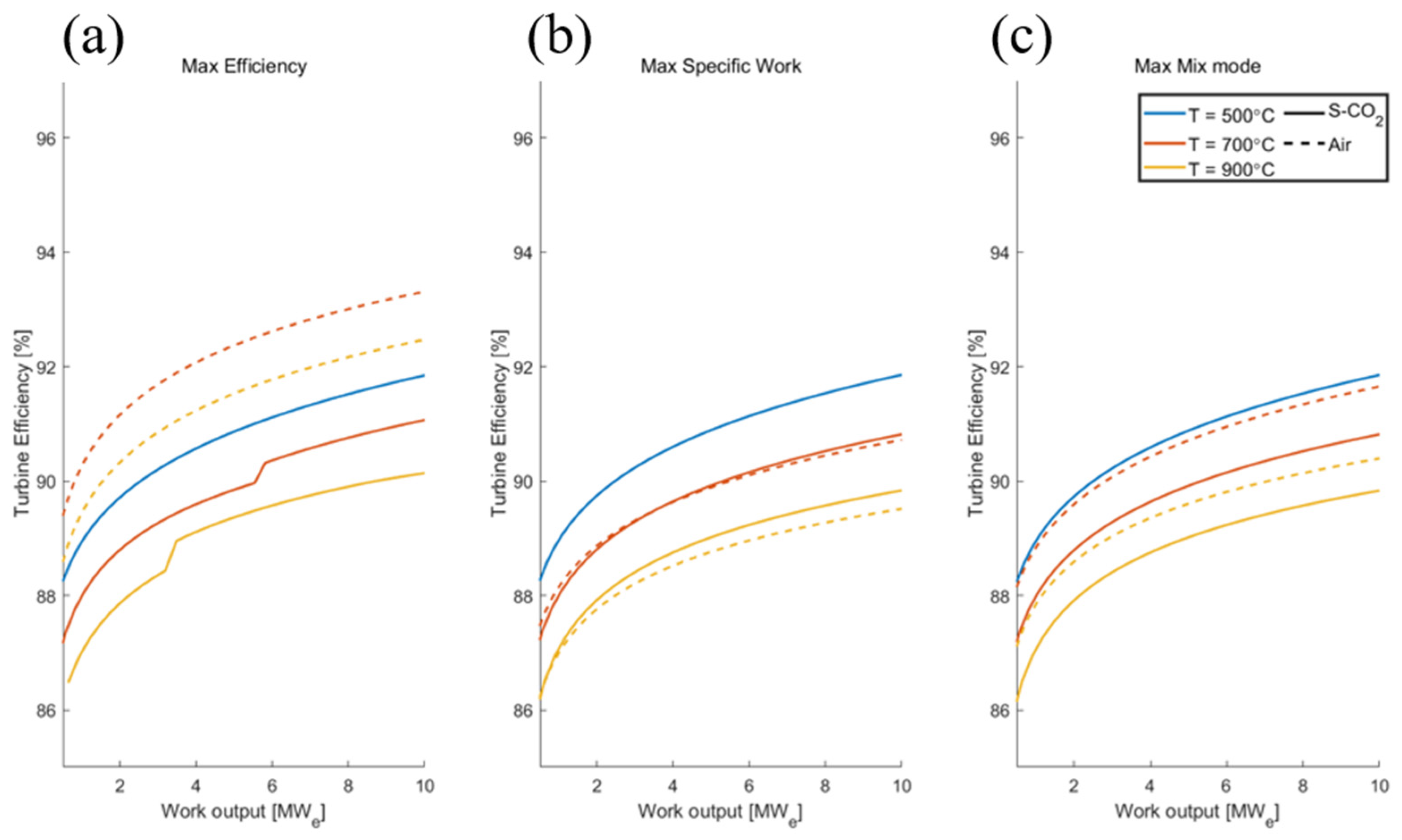
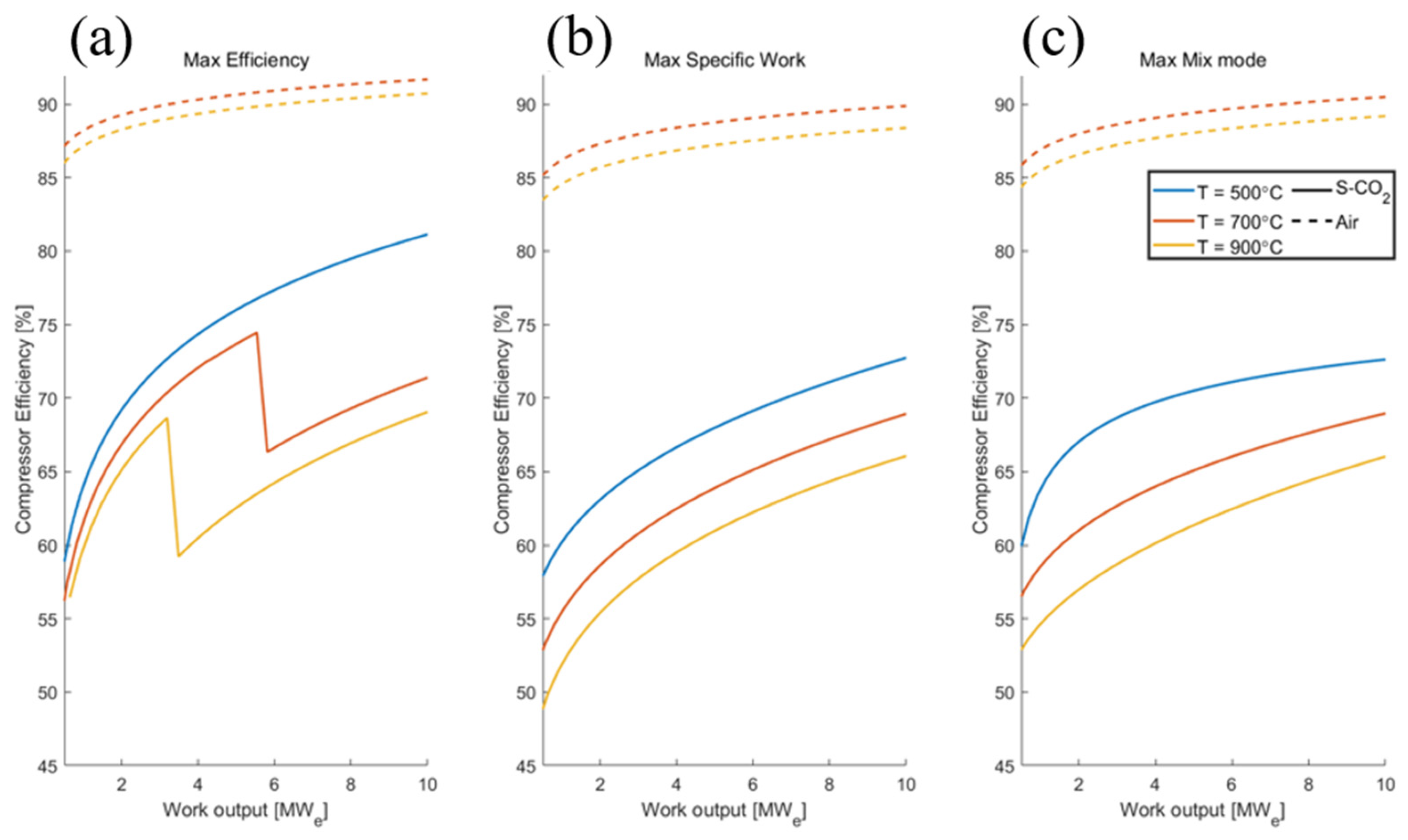
| Design Parameter | Value |
|---|---|
| Maximum Pressure | 20 MPa |
| Maximum Temperature | 500, 700, 900 °C |
| Minimum Temperature | 35 °C |
| IHX Pressure Drop | 2.01% |
| Recuperator Hot-side Pressure Drop | 1.71% |
| Recuperator Cold-side Pressure Drop | 0.5% |
| Cooler Pressure Drop | 2.39% |
| Design Parameter | Value |
|---|---|
| Minimum Pressure | 101.325 kPa |
| Maximum Temperature | 700, 900 °C |
| Minimum Temperature | 35 °C |
| IHX Pressure Drop | 4.00% |
| Recuperator Hot-side Pressure Drop | 2.00% |
| Recuperator Cold-side Pressure Drop | 2.00% |
Disclaimer/Publisher’s Note: The statements, opinions and data contained in all publications are solely those of the individual author(s) and contributor(s) and not of MDPI and/or the editor(s). MDPI and/or the editor(s) disclaim responsibility for any injury to people or property resulting from any ideas, methods, instructions or products referred to in the content. |
© 2023 by the authors. Licensee MDPI, Basel, Switzerland. This article is an open access article distributed under the terms and conditions of the Creative Commons Attribution (CC BY) license (https://creativecommons.org/licenses/by/4.0/).
Share and Cite
Choi, S.; Son, I.W.; Lee, J.I. Comparative Performance Evaluation of Gas Brayton Cycle for Micro–Nuclear Reactors. Energies 2023, 16, 2065. https://doi.org/10.3390/en16042065
Choi S, Son IW, Lee JI. Comparative Performance Evaluation of Gas Brayton Cycle for Micro–Nuclear Reactors. Energies. 2023; 16(4):2065. https://doi.org/10.3390/en16042065
Chicago/Turabian StyleChoi, Sungwook, In Woo Son, and Jeong Ik Lee. 2023. "Comparative Performance Evaluation of Gas Brayton Cycle for Micro–Nuclear Reactors" Energies 16, no. 4: 2065. https://doi.org/10.3390/en16042065
APA StyleChoi, S., Son, I. W., & Lee, J. I. (2023). Comparative Performance Evaluation of Gas Brayton Cycle for Micro–Nuclear Reactors. Energies, 16(4), 2065. https://doi.org/10.3390/en16042065








